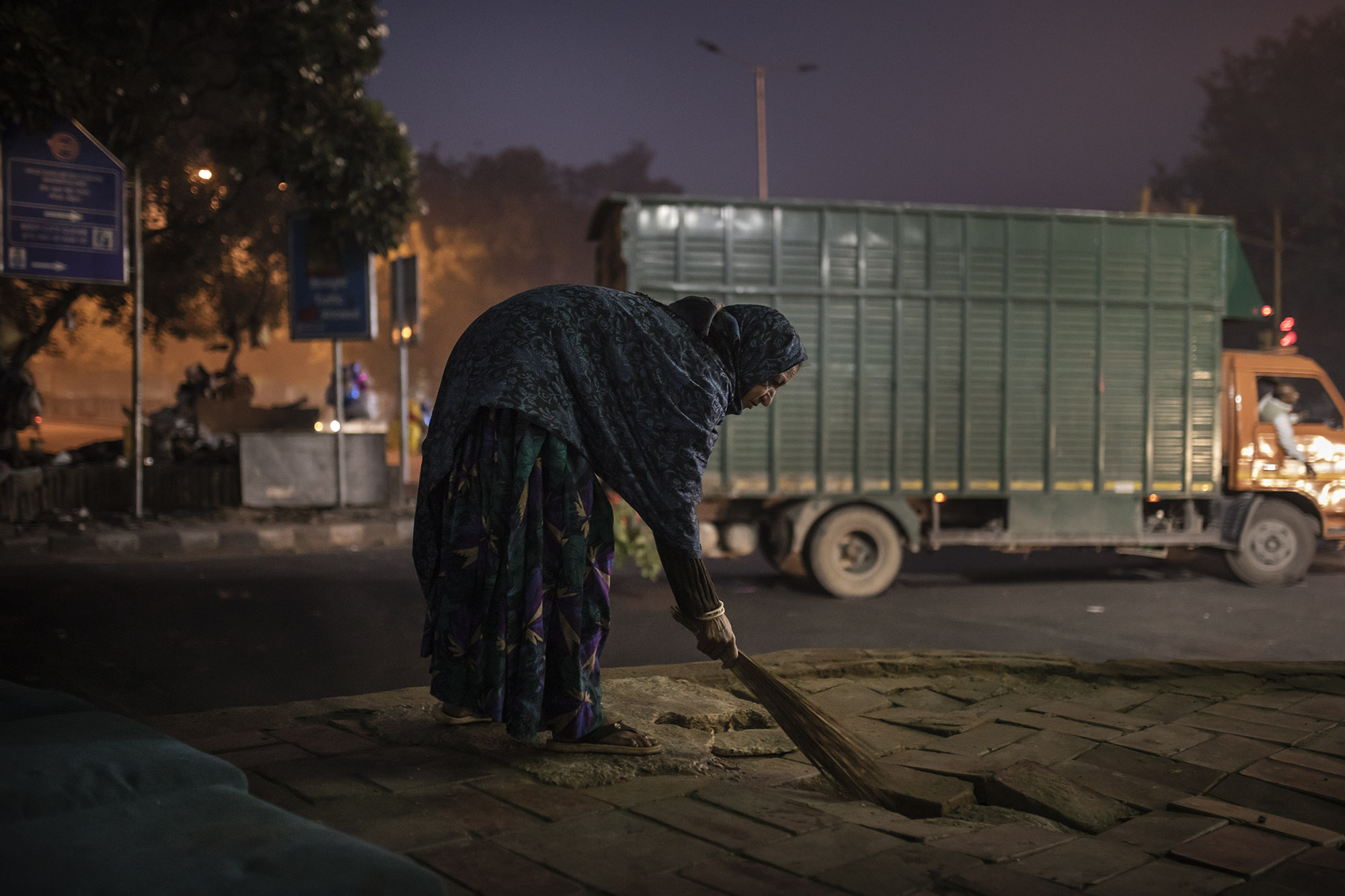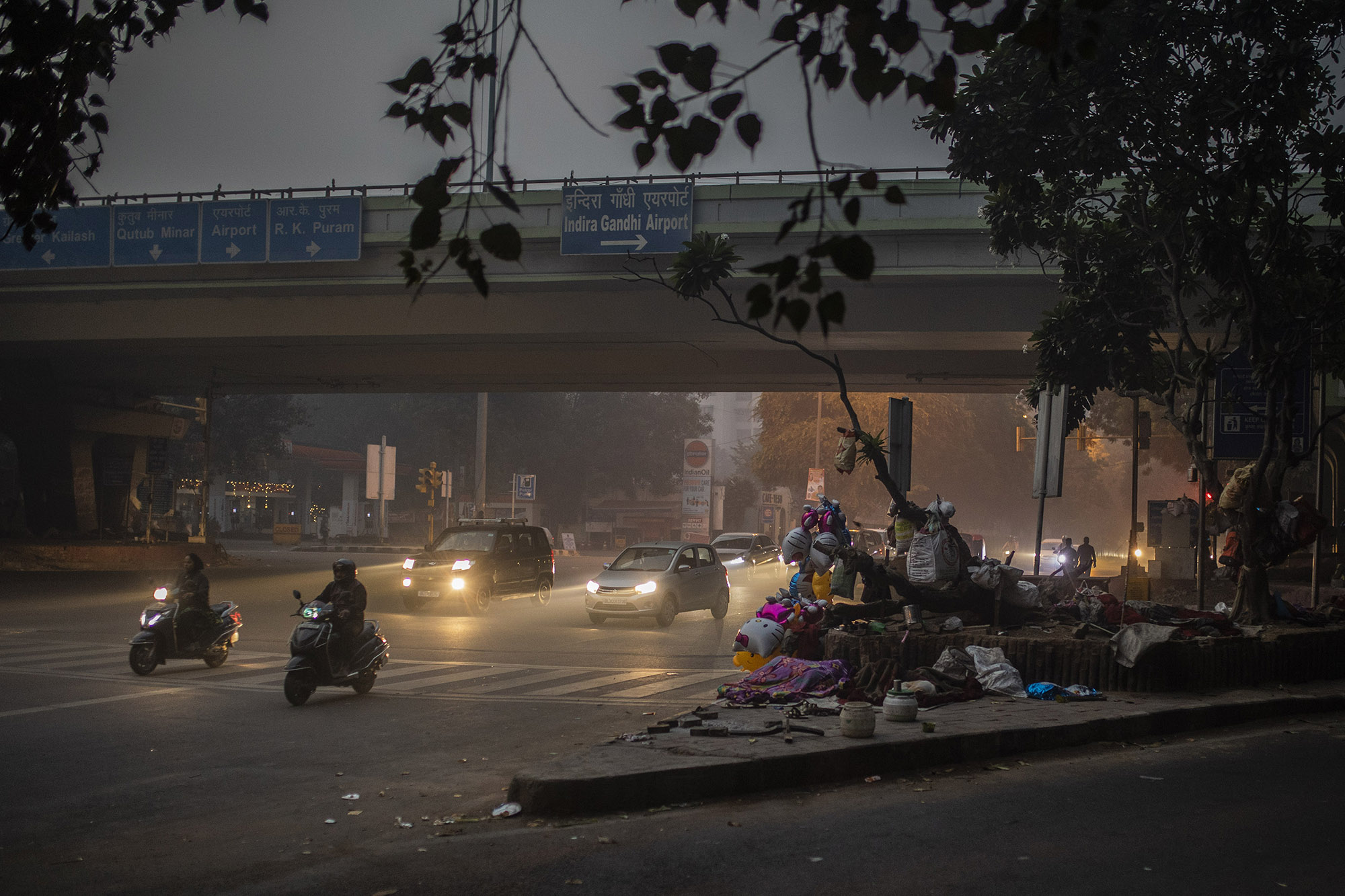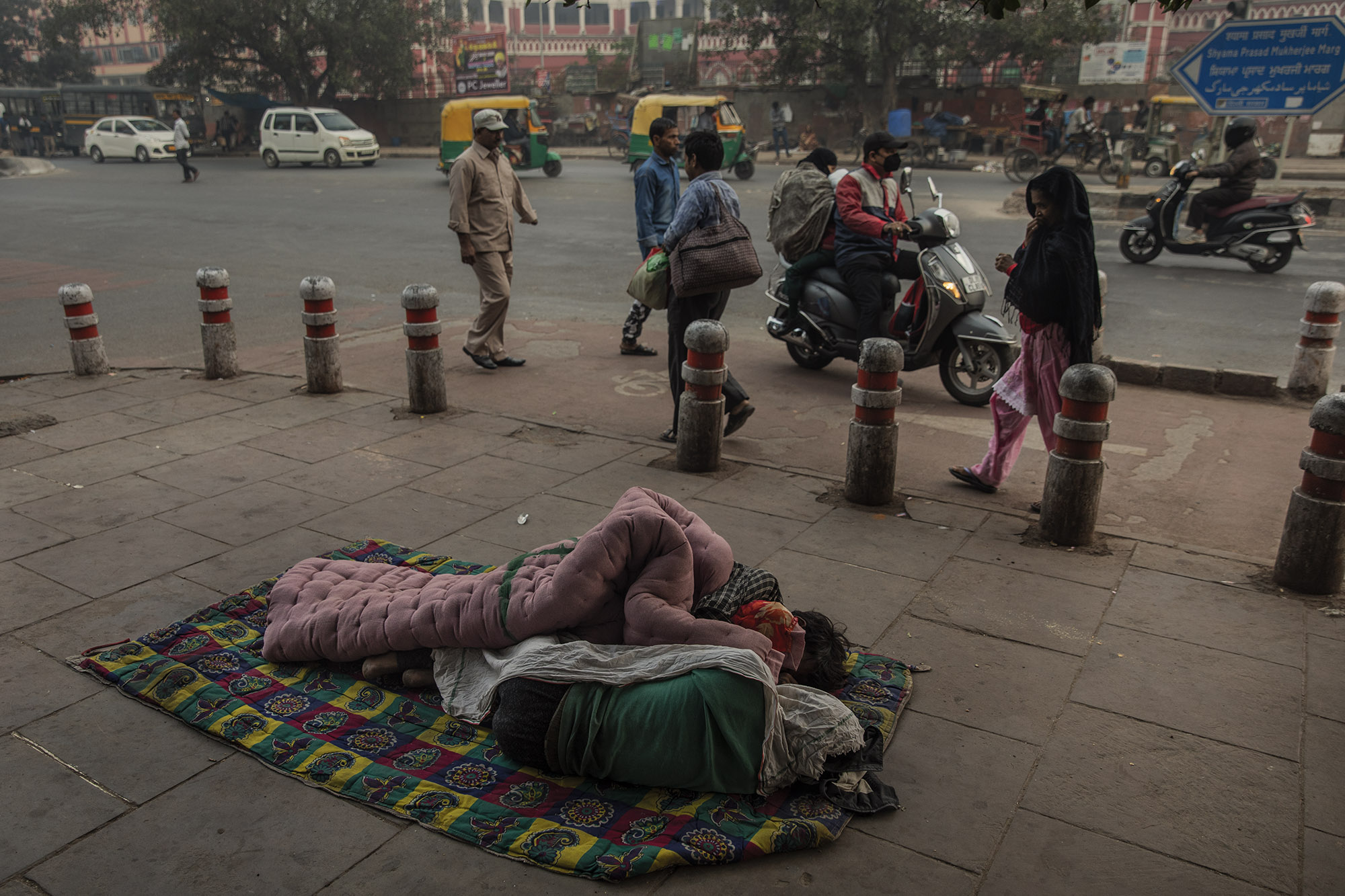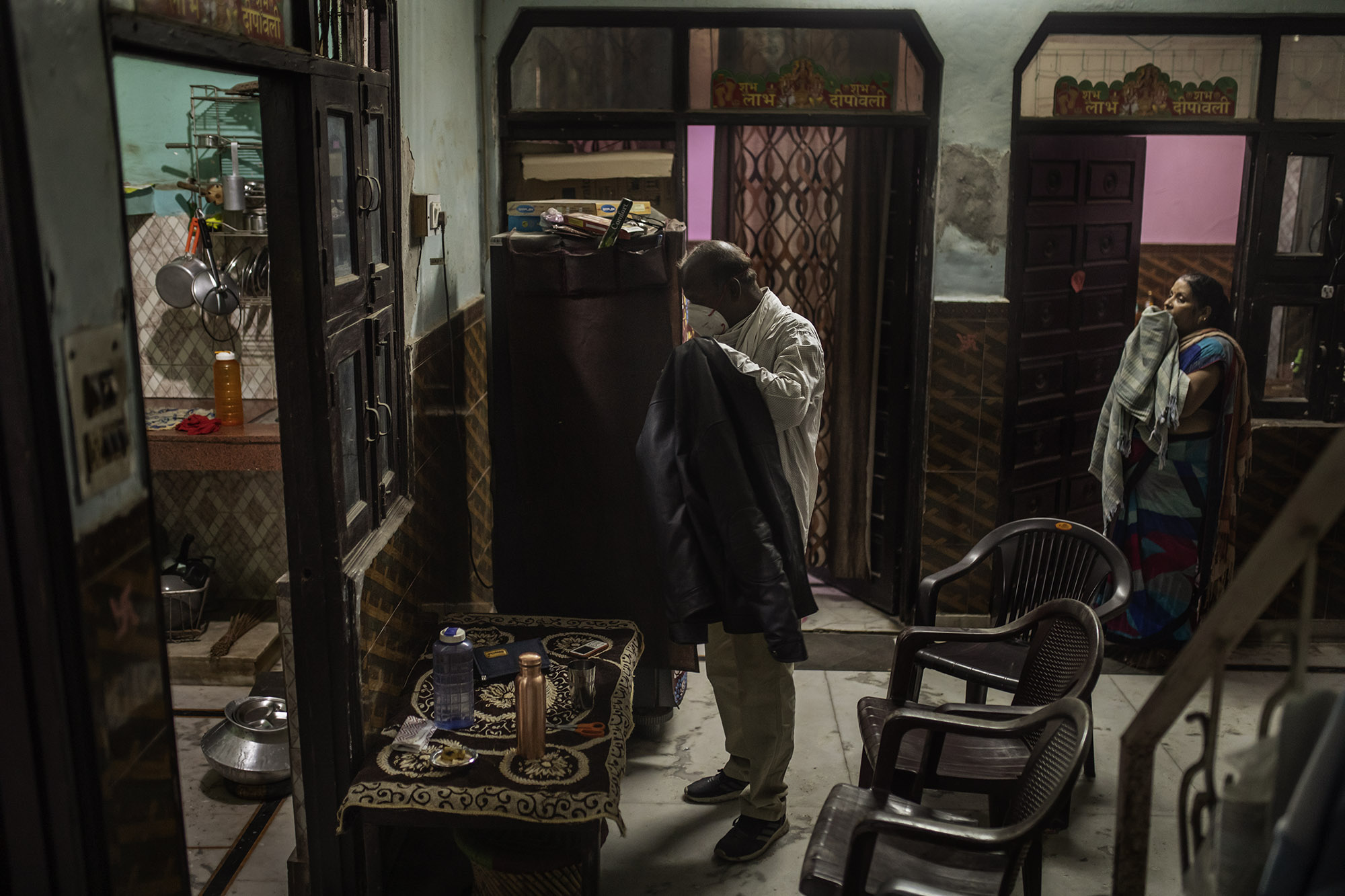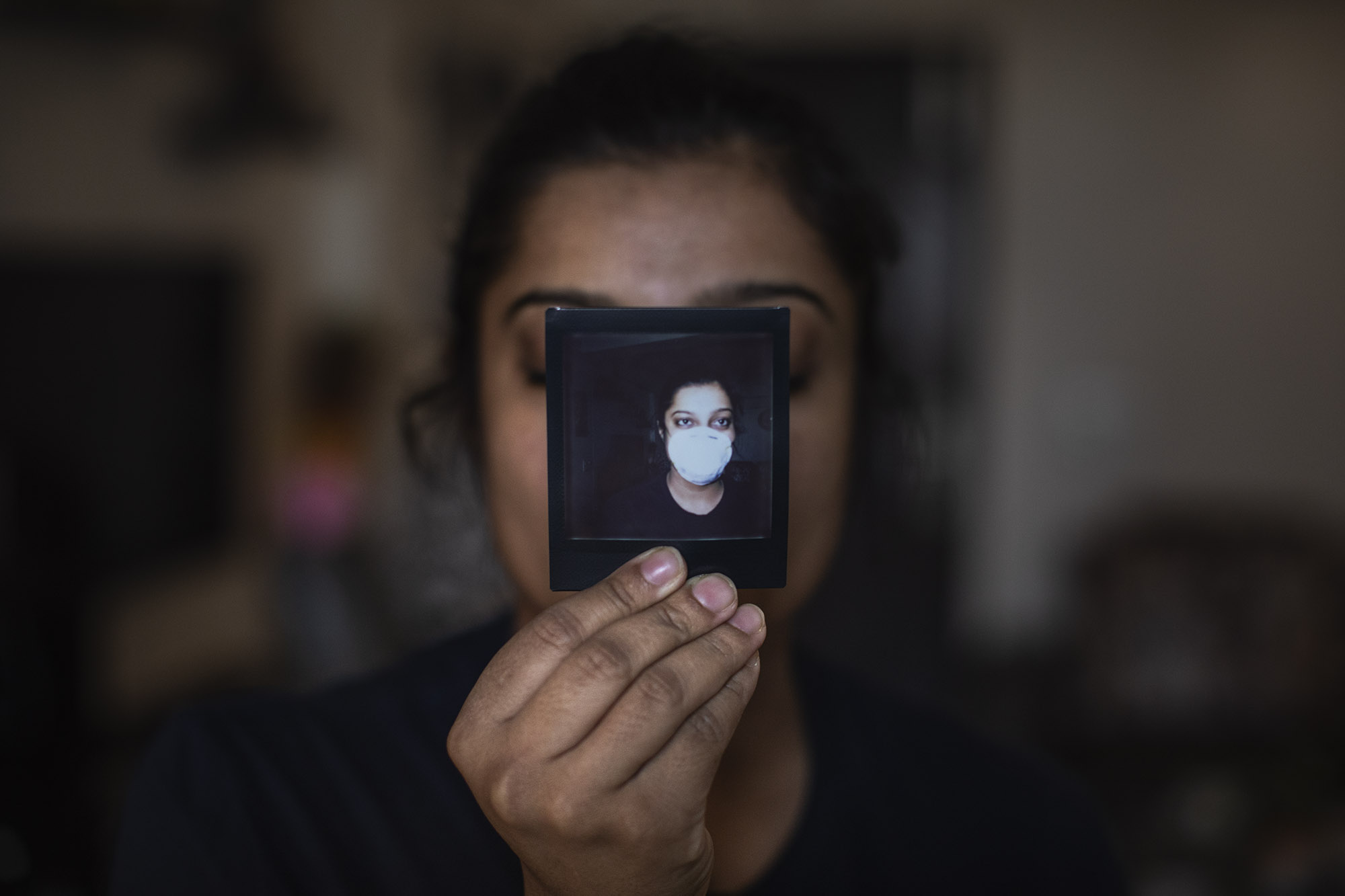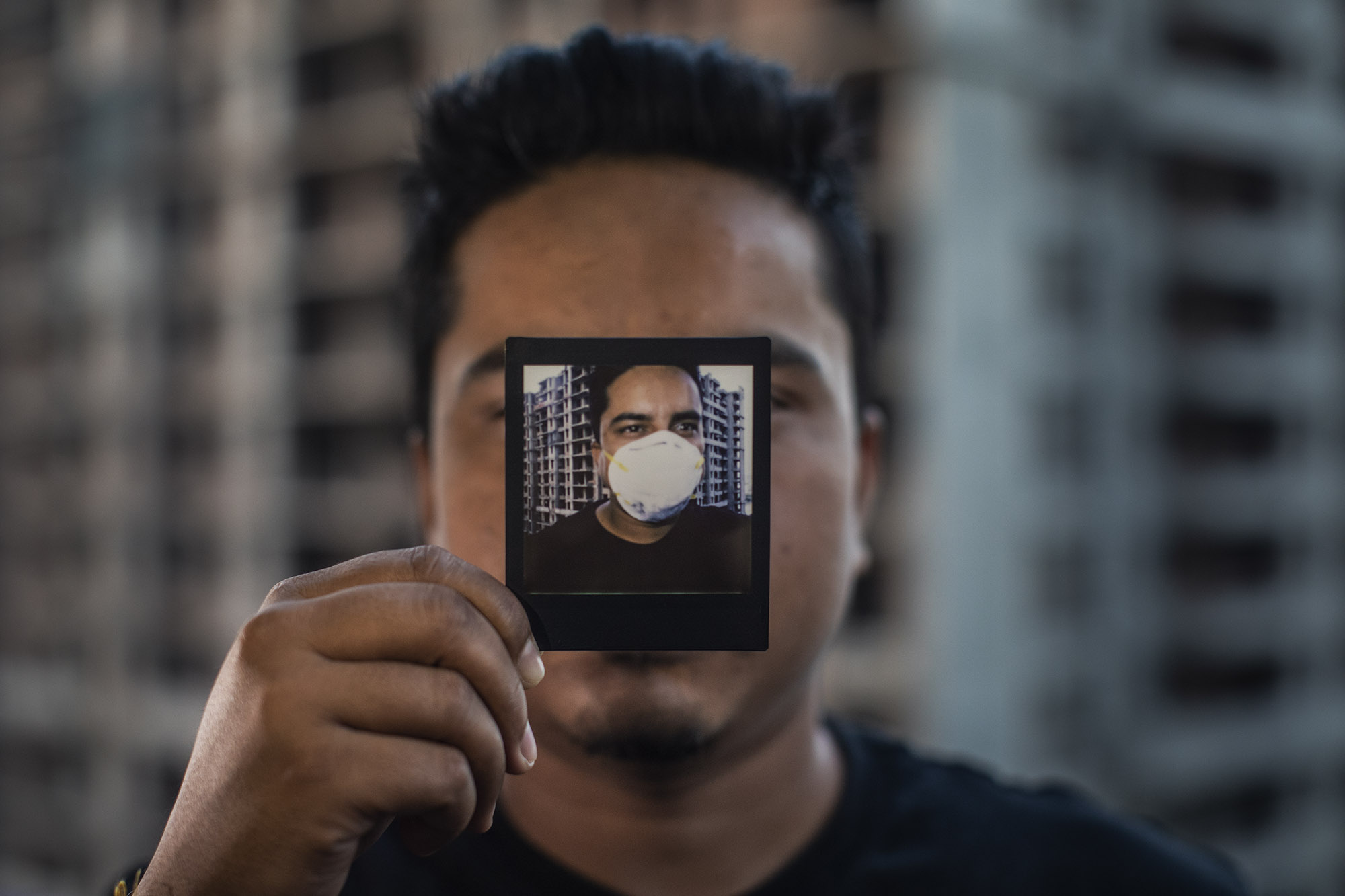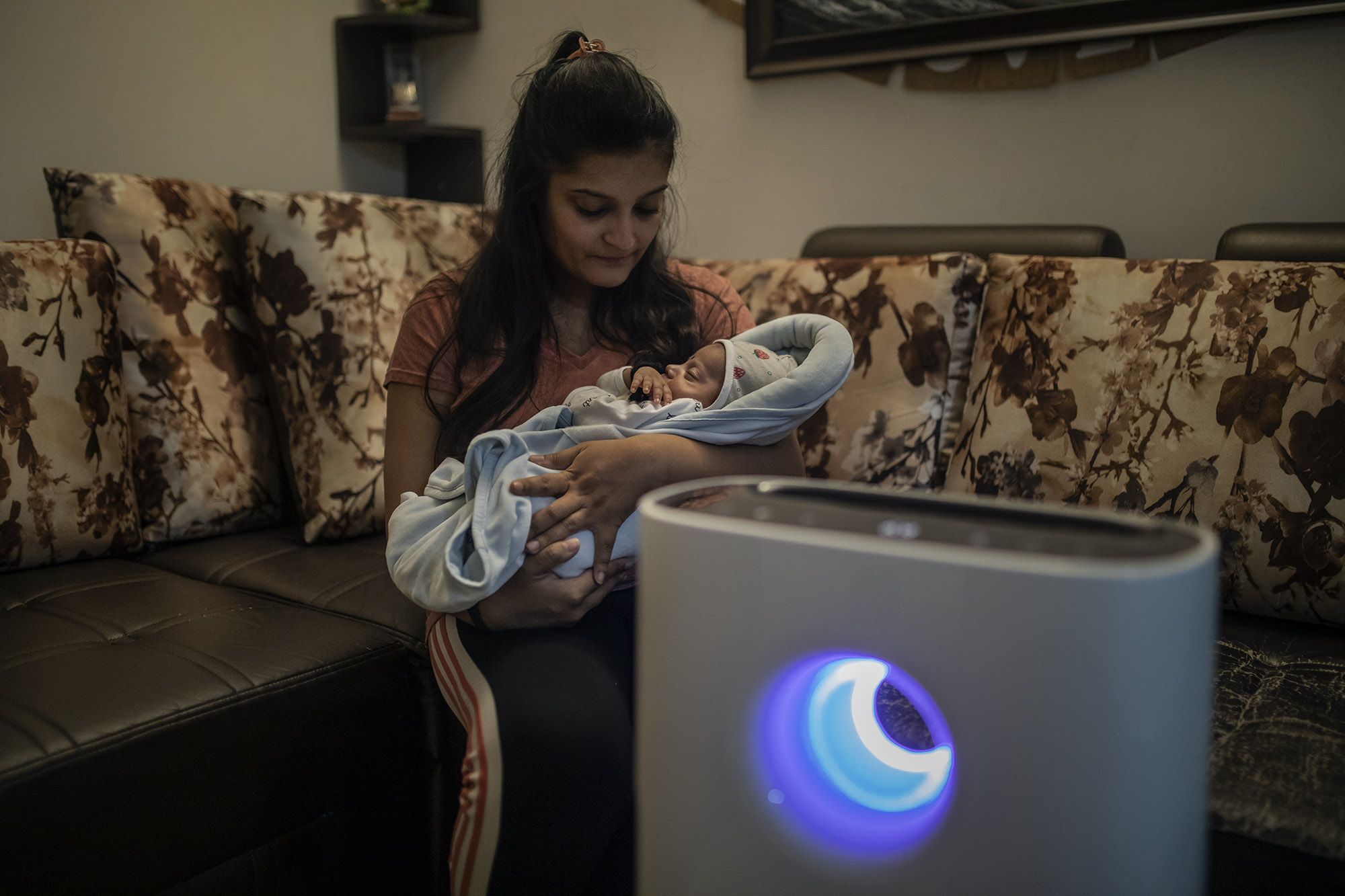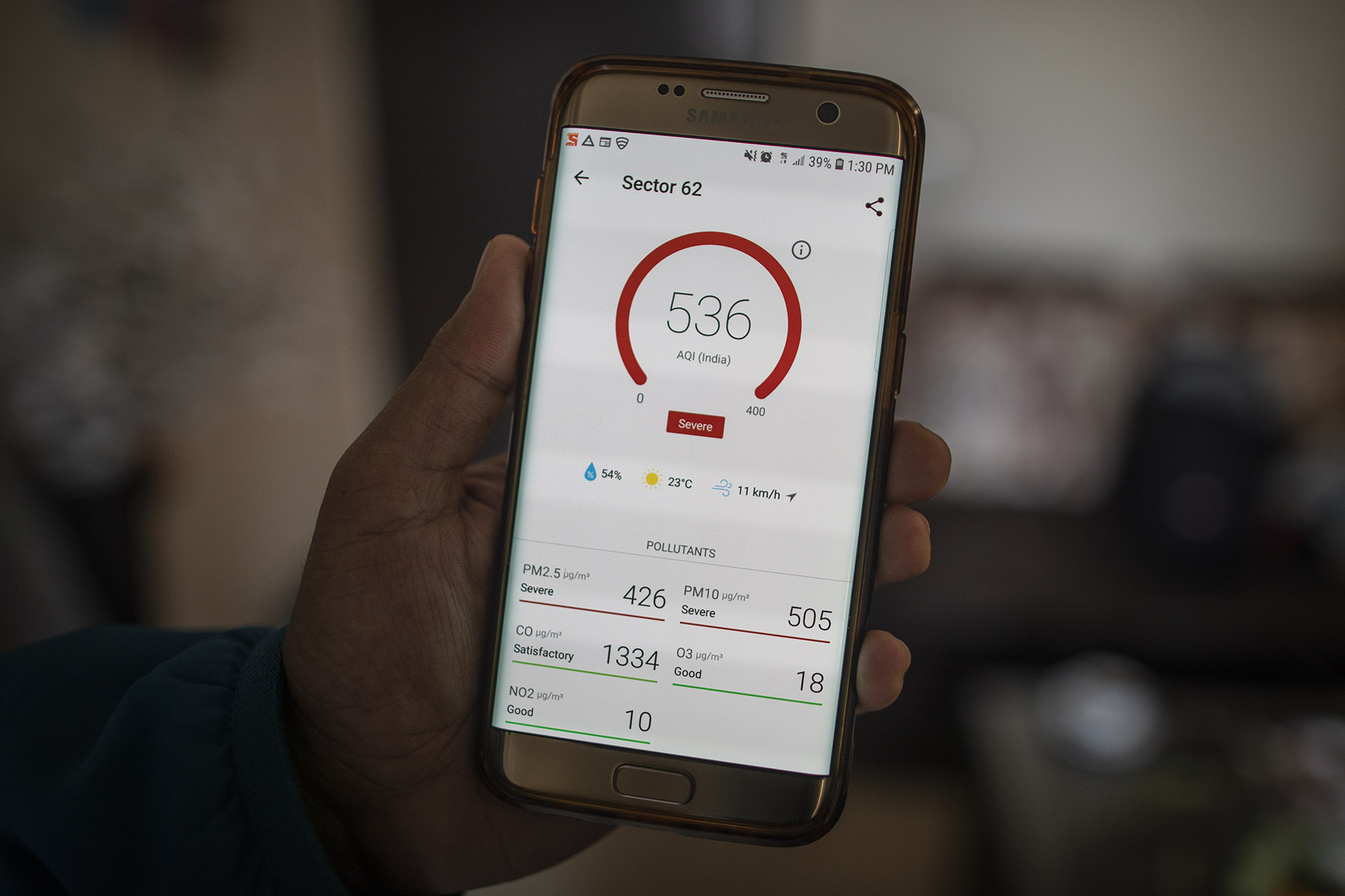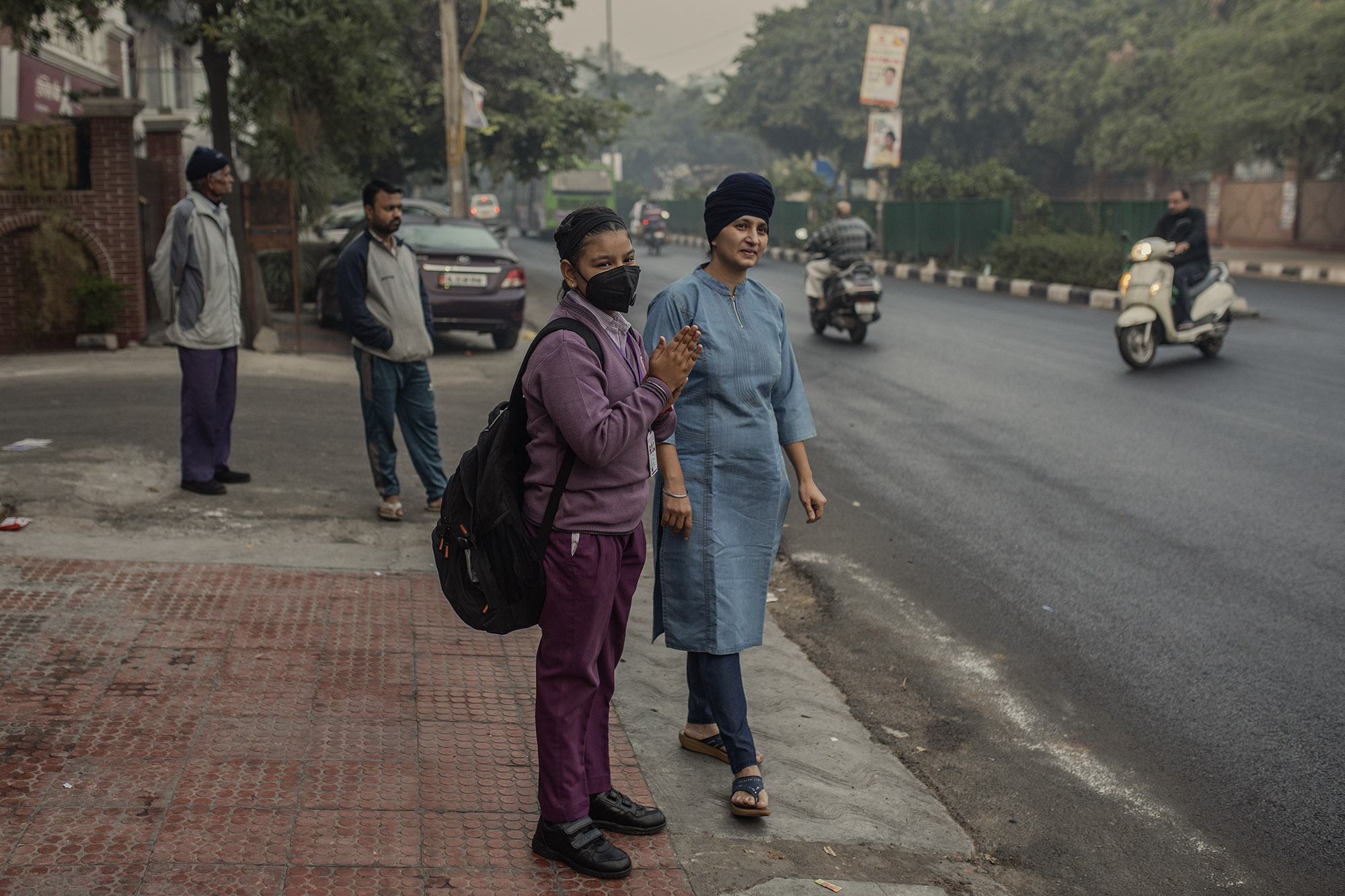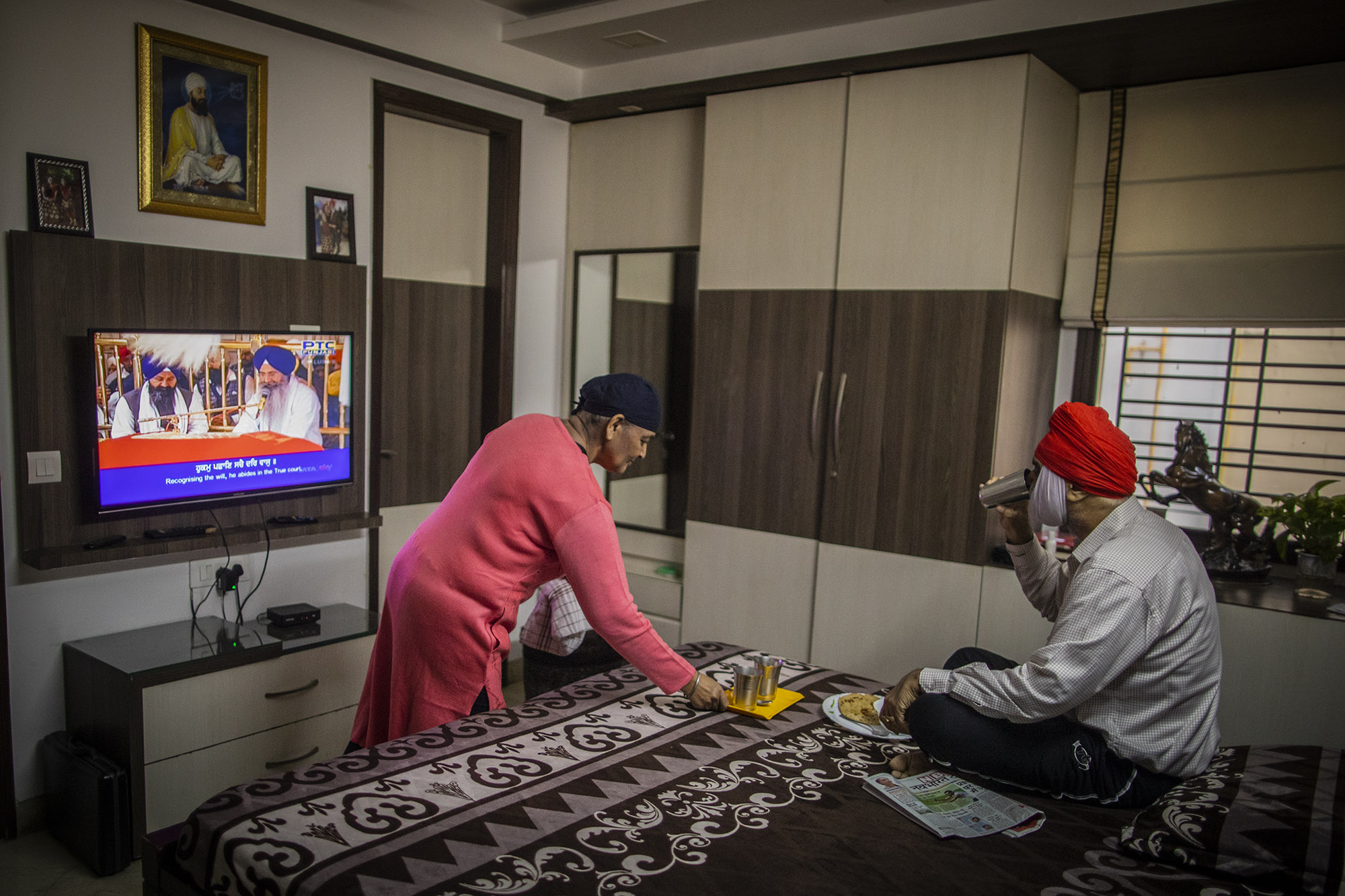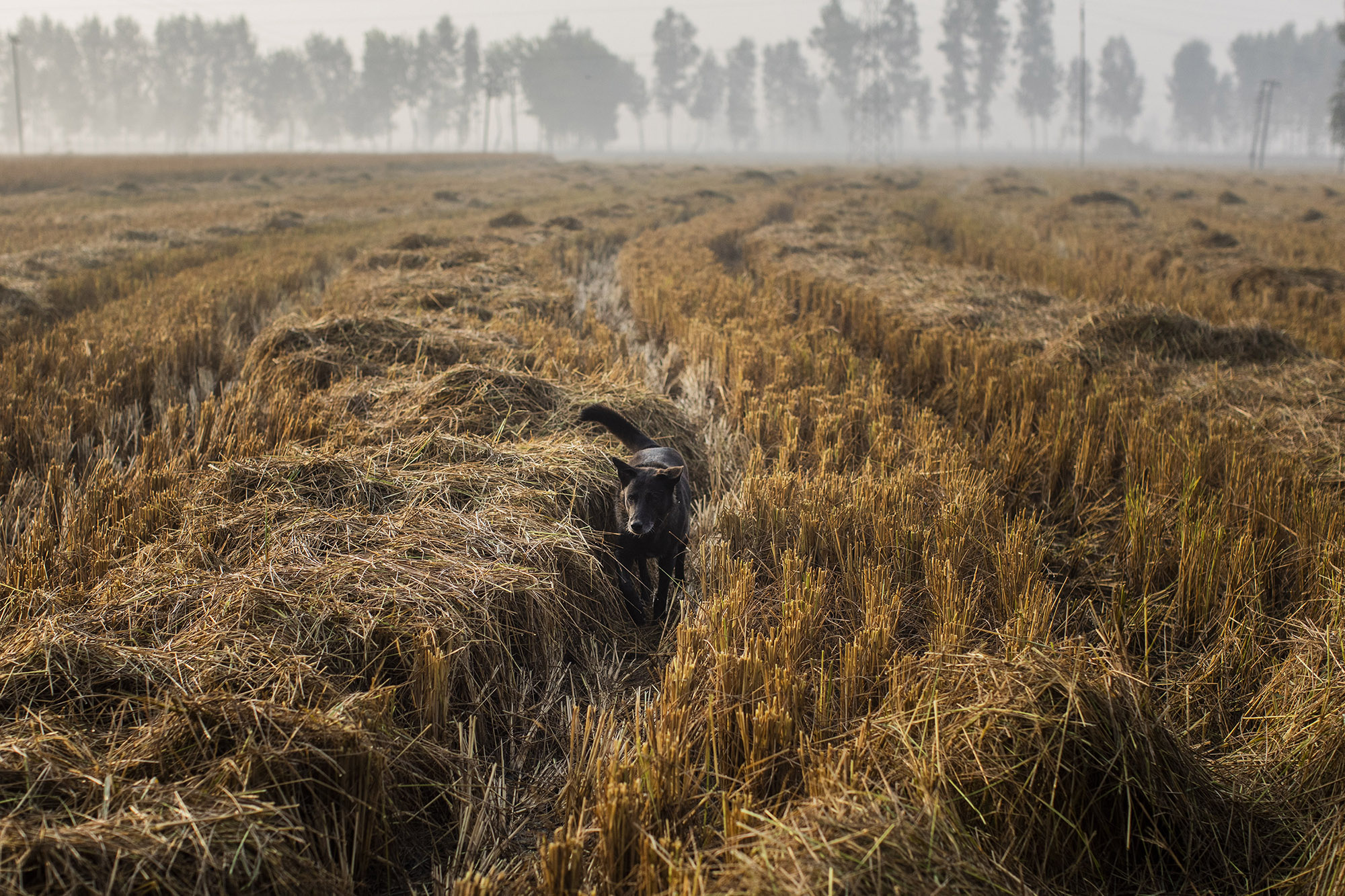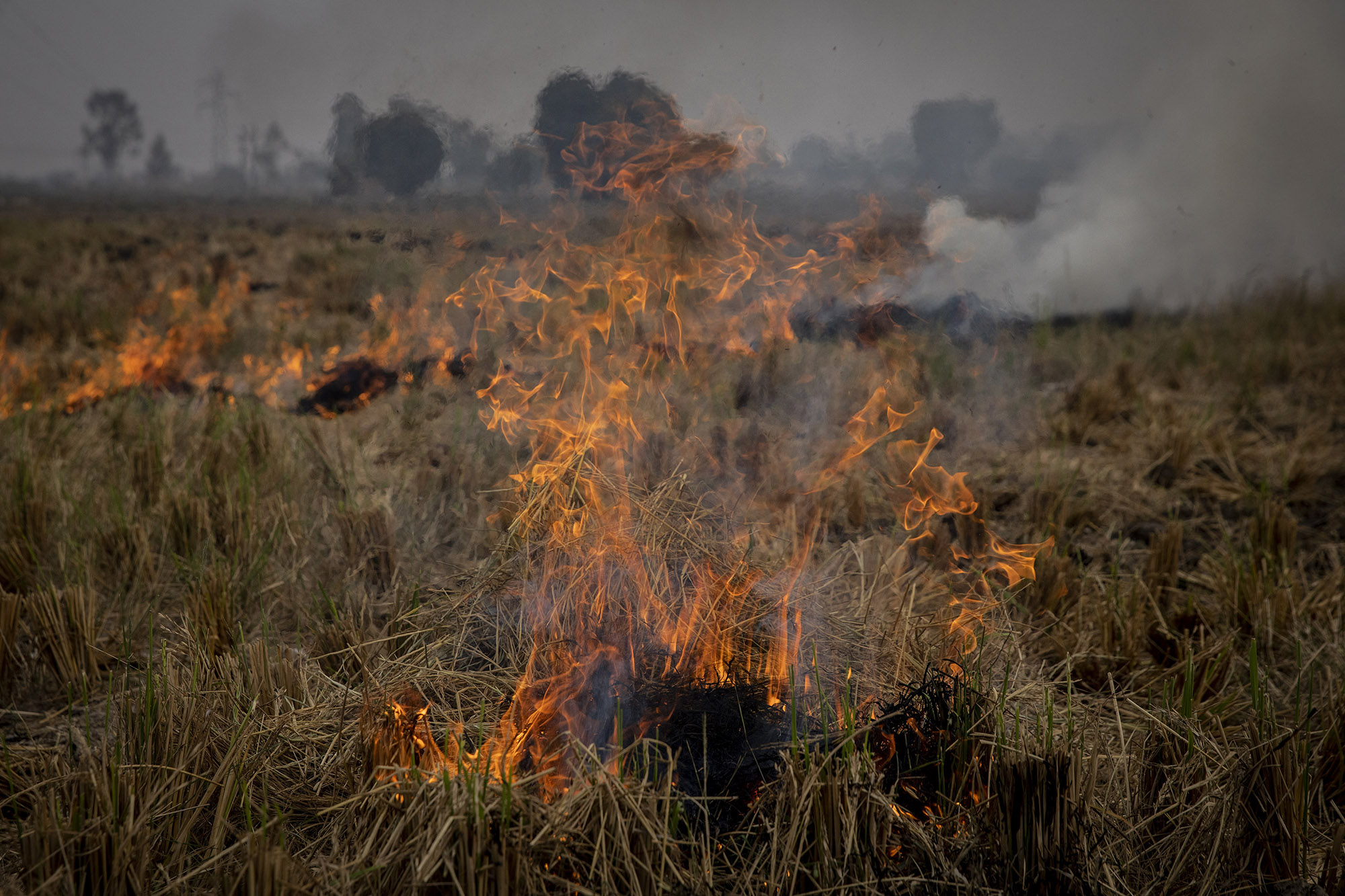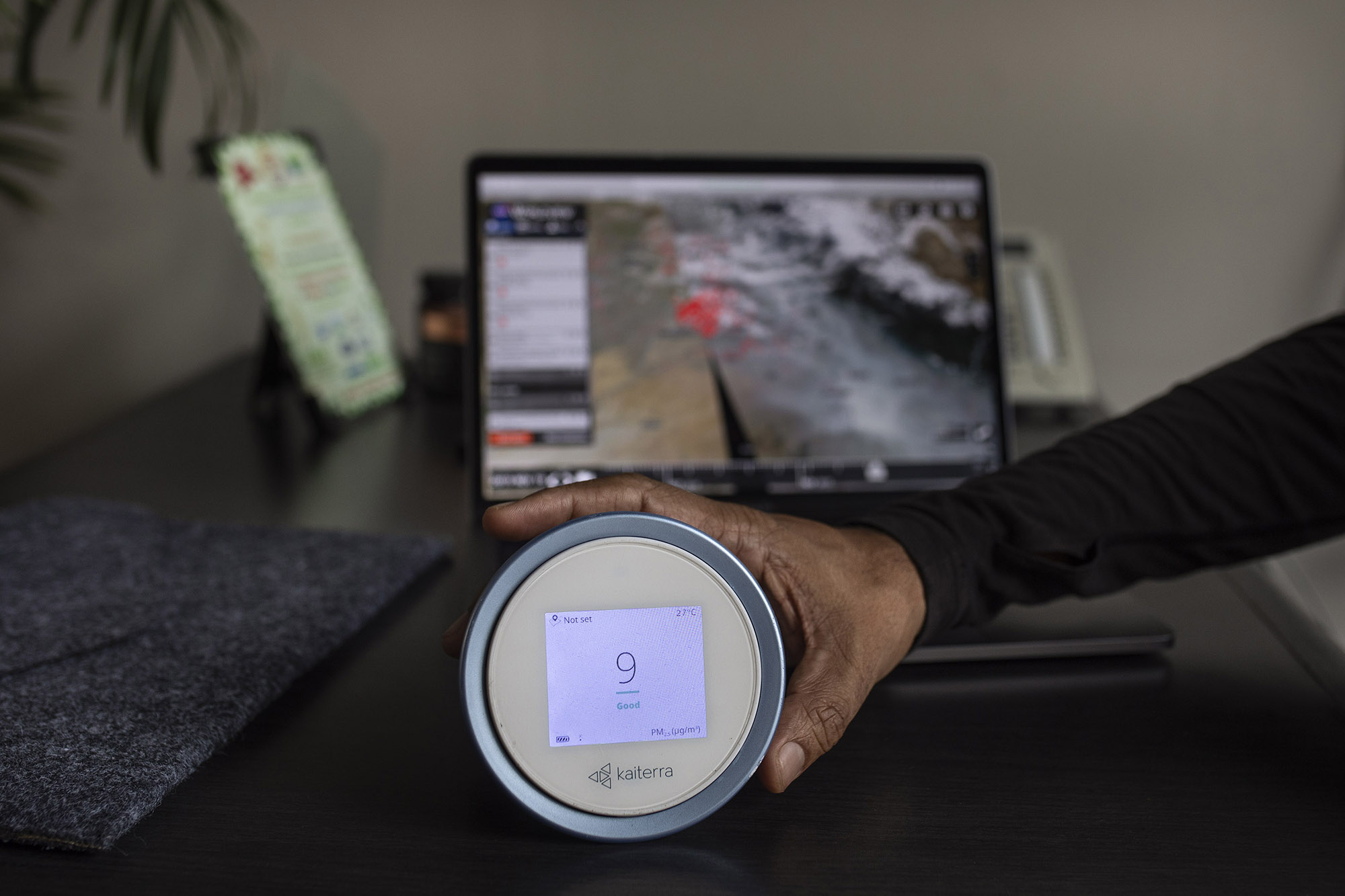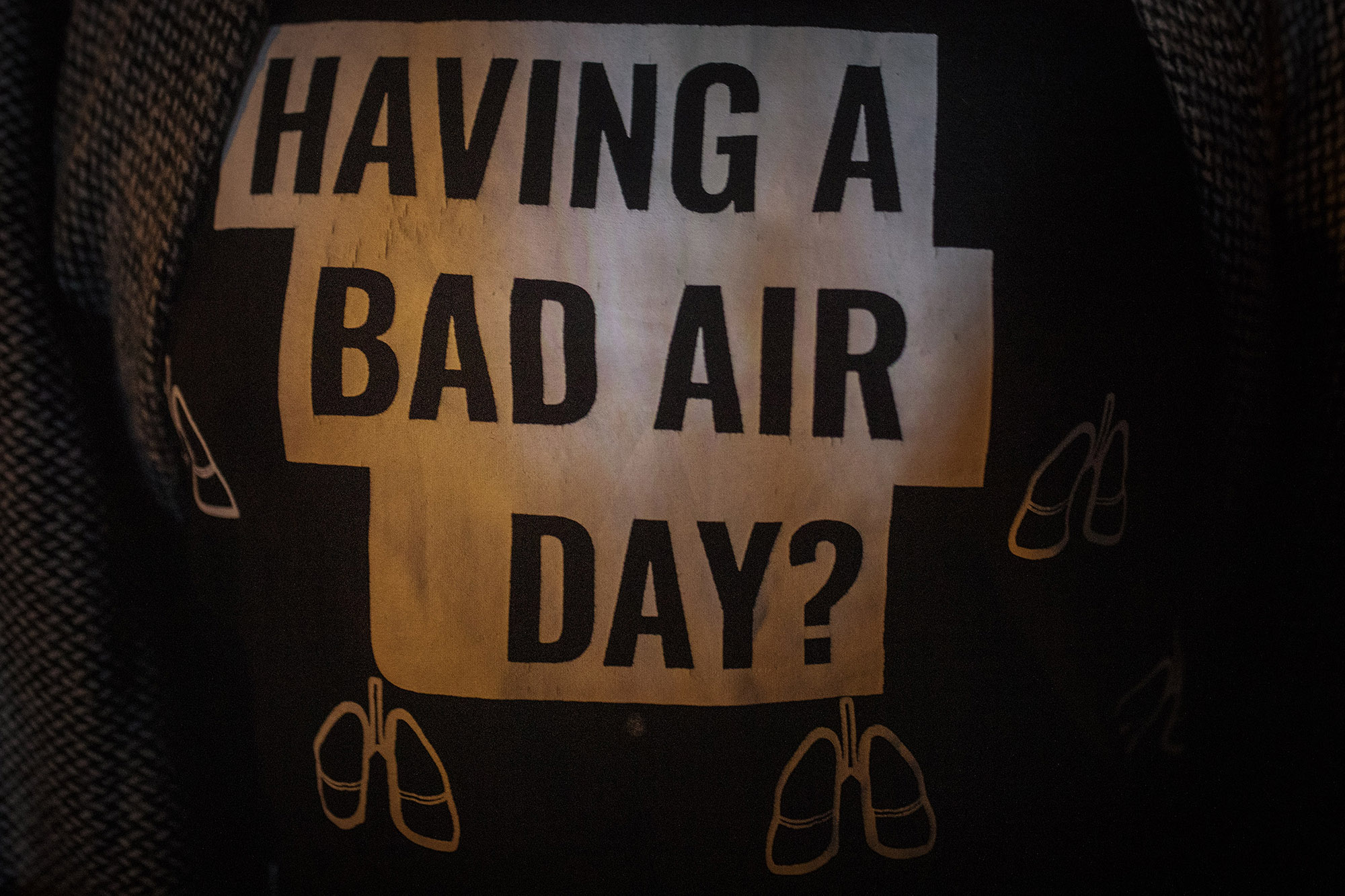© Santi Palacios for Sonda Internacional
Project summary
#megacities&pollutionMegacities and pollution
Megacities and Pollution: The Asian Epicenter is a photodocumentary project that analyzes three of the greatest environmental challenges of the 21st century: plastic waste, poor air quality and water pollution. The project focuses on three megacities in Asia, the most populated continent in the world: Metro Manila, Delhi and Jakarta.
Megacities and pollution
We Thought it Was Fog
New Delhi: The world’s most polluted capi...


Join our crowdfunding!
Take the opportunity to directly support in-depth journalism on the climate crisis
Donate
25 October 2022
Nearly everyone in the world is breathing polluted air. This is not simply a manner of speaking: 99% of the world’s population breathes polluted air that exceeds the recommended limits, according to figures published by the World Health Organization (WHO). Each year nearly seven million people die prematurely as a result of exposure to this toxic air. And, while the atmosphere knows no borders, the populations of low and middle-income countries experience greater exposure to unhealthy air.
The list of identified unhealthy air pollutants is extensive: carbon monoxide, nitrogen oxides, lead, ground-level ozone and sulfur oxides, the majority of which result from the burning of fossil fuels. The list also includes particulate matter (PM), microscopic particles so small that they can be inhaled, causing serious health problems.
New Delhi, in India, is the capital city with the worst air quality in the world. Nearly 28 million inhabitants in the Delhi metropolitan area breathe a toxic cocktail that becomes worse in winter, when meteorological factors cause the pollution to condense even further in the city. Spikes in pollution can rocket particle levels to 40 times what is considered safe by WHO.
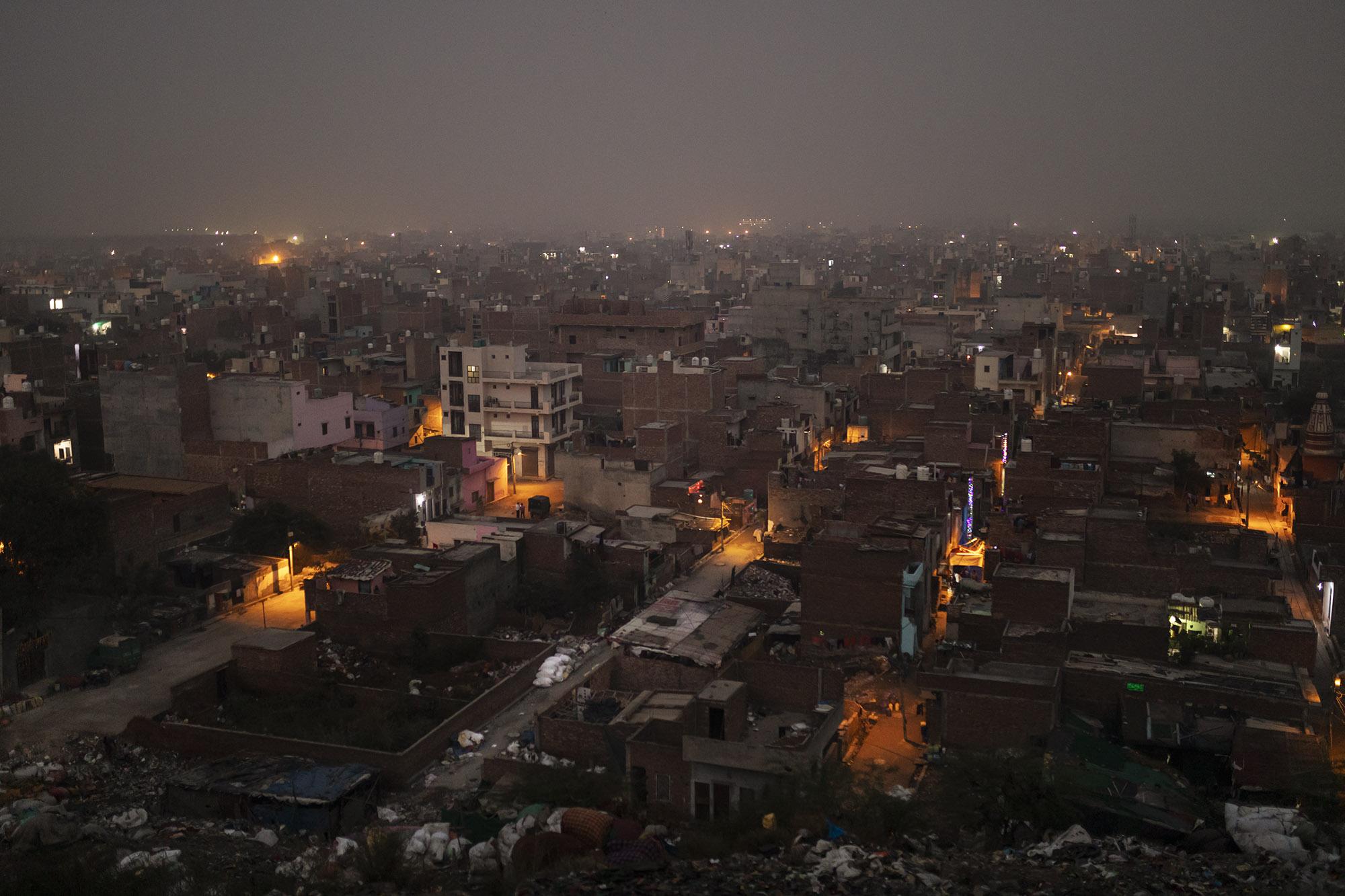
A large shanty town at the foot of the Bhalswa landfill, Delhi. © Santi Palacios para Sonda Internacional
Located in the northern part of the Indian subcontinent, Delhi spreads out over an area of more than 570 square miles. Its official name is the National Capital Territory of Delhi, and it is divided into eleven districts, one of which is New Delhi, the seat of the country's executive, legislative and judicial powers.
Delhi tops the list of the most polluted capitals in the world based on a classification of air quality indicators that include PM2.5, which is particulate matter with a diameter of less than 2.5 micrometers, thirty times smaller than the thickness of a human hair. These particles —which can include organic chemicals, dust, soot and metals— can enter the bloodstream and increase the risk of coronary disease, stroke, respiratory illness and cancer. The level of PM2.5 has become one of the most important indicators for detecting urban air quality.
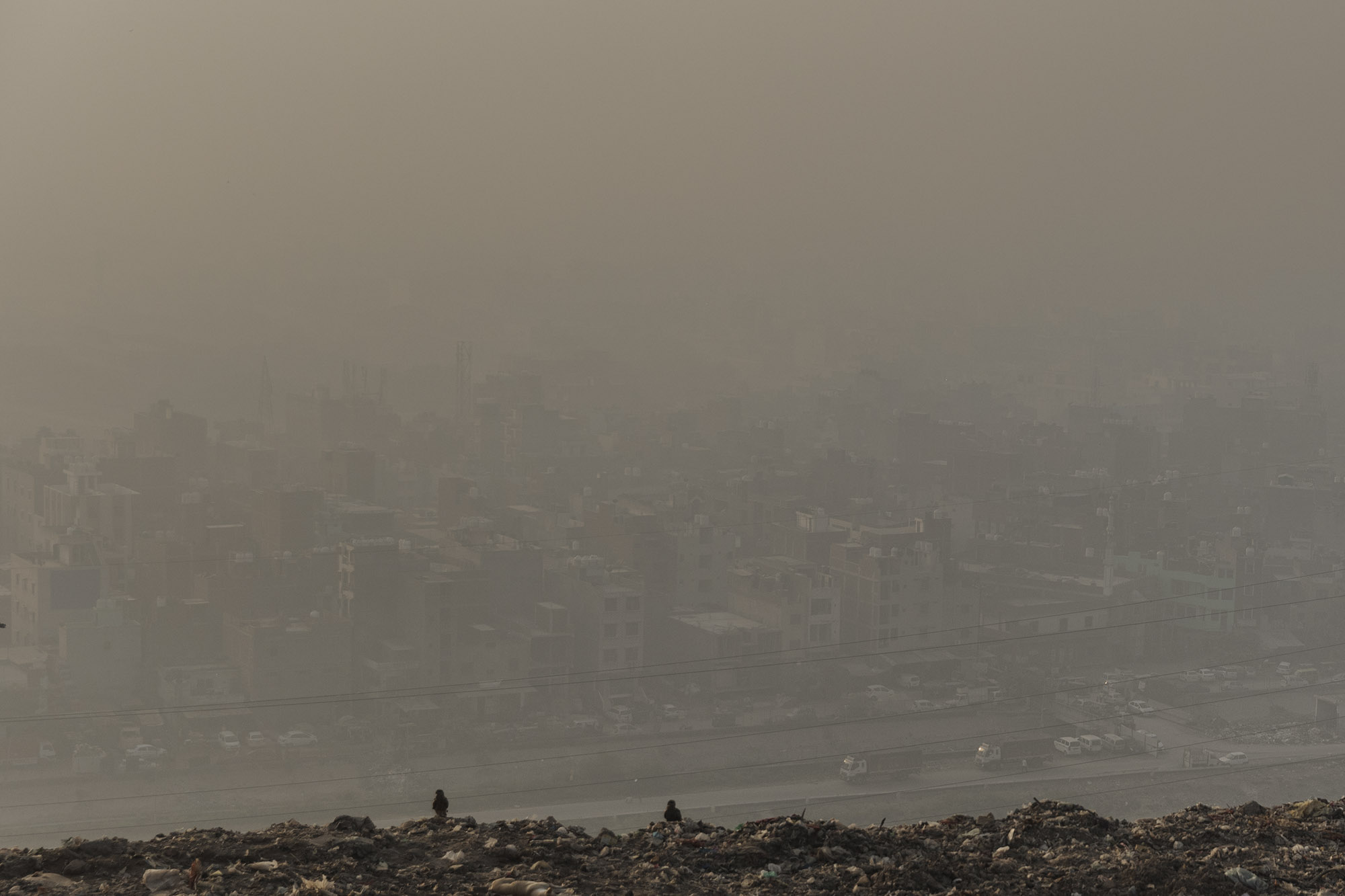
Smog chokes the neighborhoods surrounding the Ghazipur landfill, Delhi. © Santi Palacios para Sonda Internacional
The new WHO global air quality guidelines —which had last been updated 15 years ago— acknowledge that air pollution has a much bigger impact on health than previously thought, lowering the annual limit of PM2.5 to 5 micrograms (µg) per cubic meter (compared to 10 µg/m3 established in the previous revision). But every country has its own parameters. In India, the limit is 40 µg per m3 per year, four times the limit previously established by WHO.
While the pollution levels in Delhi are most often echoed in the media, the problem extends to many other cities in the country. The situation has become so alarming that the prestigious Centre for Science and Environment (CSE) has defined it as a national crisis. Measurements taken by IQAir, a global air quality information and technology company, back this interpretation: 14 of the 20 cities registering the highest levels of air pollution in the world are in India.
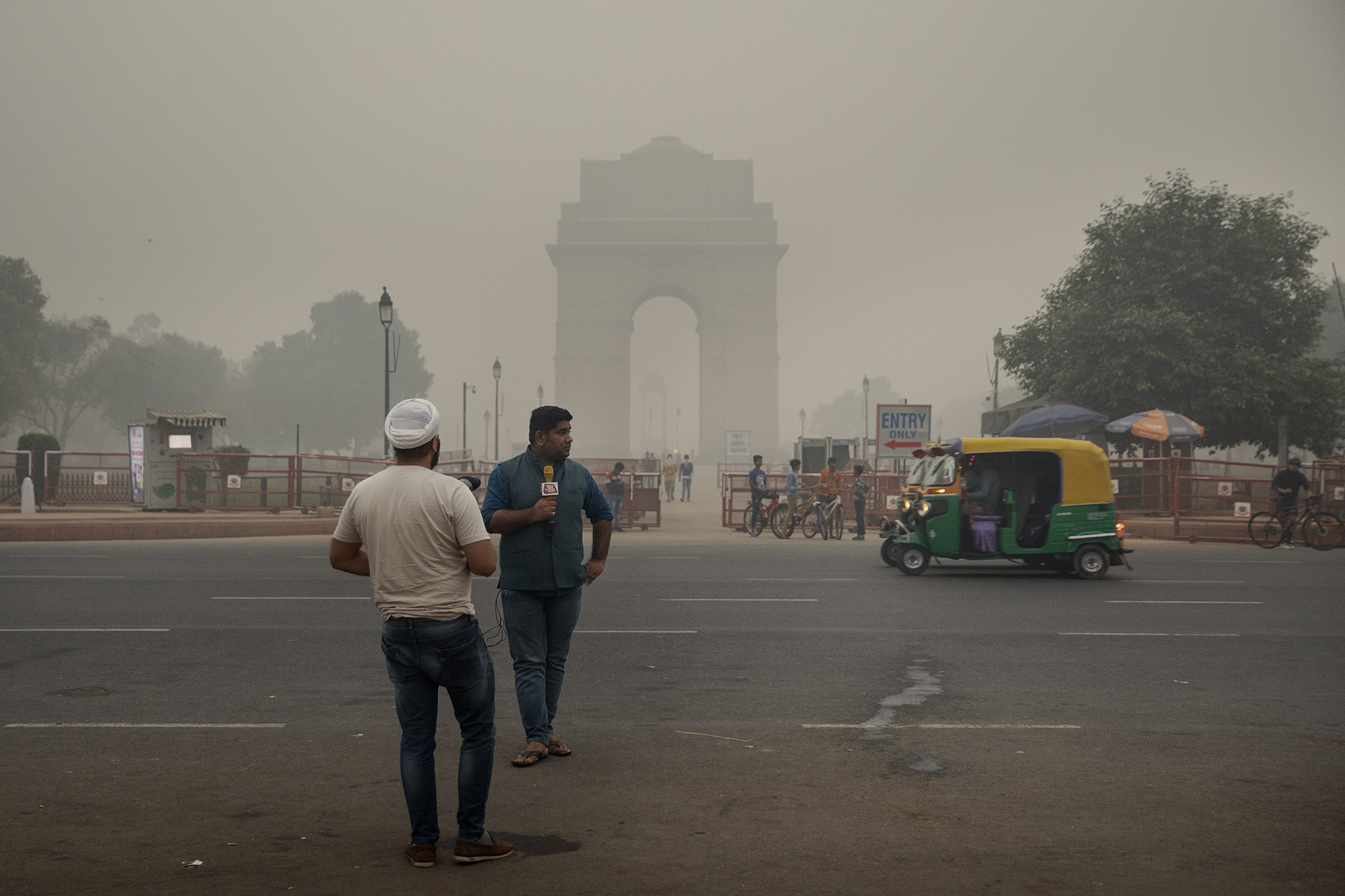
India Gate, New Delhi, photographed on different days in November. © Santi Palacios for Sonda Internacional
Several factors converge to make the Indian capital the most polluted in the world: millions of vehicles on the roads each day, outdoor burning of waste and other fuels, the presence of factories and industrial areas, constant and ongoing construction work, and extensive crop burning in neighboring regions.
Winter invariably finds this megalopolis wrapped in a blanket of smog, a mix of smoke and fog that many at first confused with simple fog or mist.
TRAFFIC
More than 13 million vehicles crowd the roads in Delhi. They are among the city’s top generators of toxic airborne particles, emitted by combustion engines and the wear and tear of tires and brakes. And according to Shambhavi Shukla, an air pollution researcher and campaigner at CSE, more than a thousand vehicles a day join the fleet. Public transport is sorely lacking in this gigantic metropolis. 2019 data indicates that there are fewer than 5,500 urban buses in the city. CSE insists that this number must be doubled at the very least in order to mitigate the problem of pollution. It is also estimated that some two million vehicles do not hold an updated pollution control certificate, which certifies that a vehicle complies with emission standards.
Some steps have been taken in recent years in an attempt to reduce traffic-induced pollution. Trucks are subject to an environmental road tax, and ring roads have been built to avoid trucks rumbling through the city center. Restrictions have been placed on older vehicles, and the use of cleaner fuels is being expanded. When pollution spikes well above accepted levels, the even-odd rule is activated: vehicles are limited to driving on certain days depending on their license plate number. These are emergency measures, “but we need to do even more,” says Shukla. “We need a massive public transport system.”
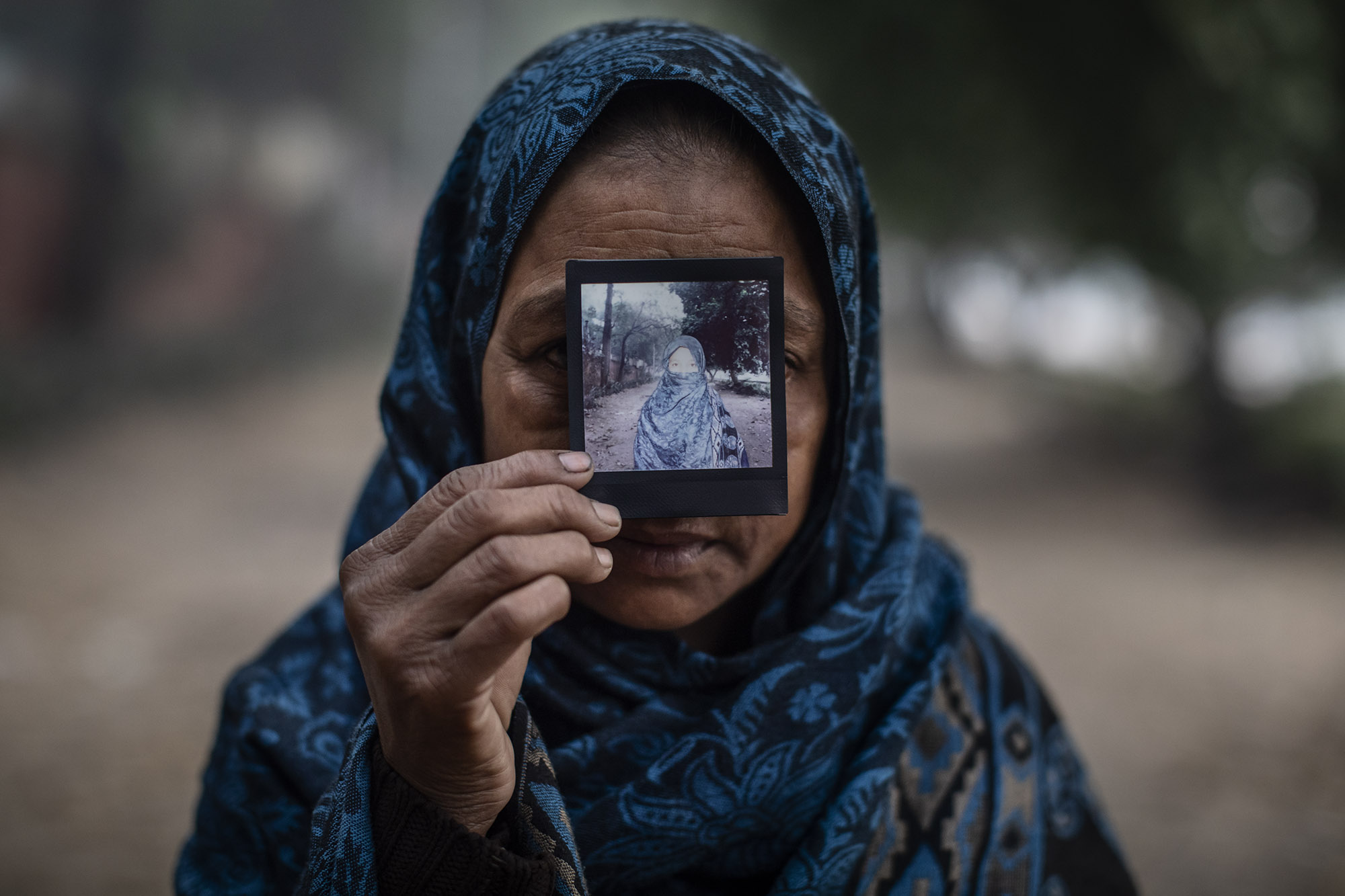
Rukmani holds up a photo which shows her protecting her nose and mouth with a shawl. © Santi Palacios for Sonda Internacional
Rukmani
Rukmani comes from the state of Rajasthan. She is homeless, and lives with her family under an overpass at the junction of two of the busiest freeways in the south of New Delhi. She arrived in the capital in the 1990s, when she was 24 years old and in search of a job. She has worked in construction, laying cables, and as a street vendor. She is a mother of five and grandmother of three. Now she earns a living by selling various items to the occupants of vehicles that stop at traffic lights.
Day and night, she and her family breathe the exhaust of thousands of vehicles that drive along the four-lane highway that crosses over their heads.
When she wakes up, even before the sun comes up, there are already cars driving through a mist which is actually smog. Although she has been breathing the toxic emissions of countless vehicles for years, she is unaware of the harm this can cause. “We don't notice the pollution,” she says. But when we ask her about her health, she says that her chest hurts and her eyes often water, but she does not make the connection between her physical ailments and the poor air quality.
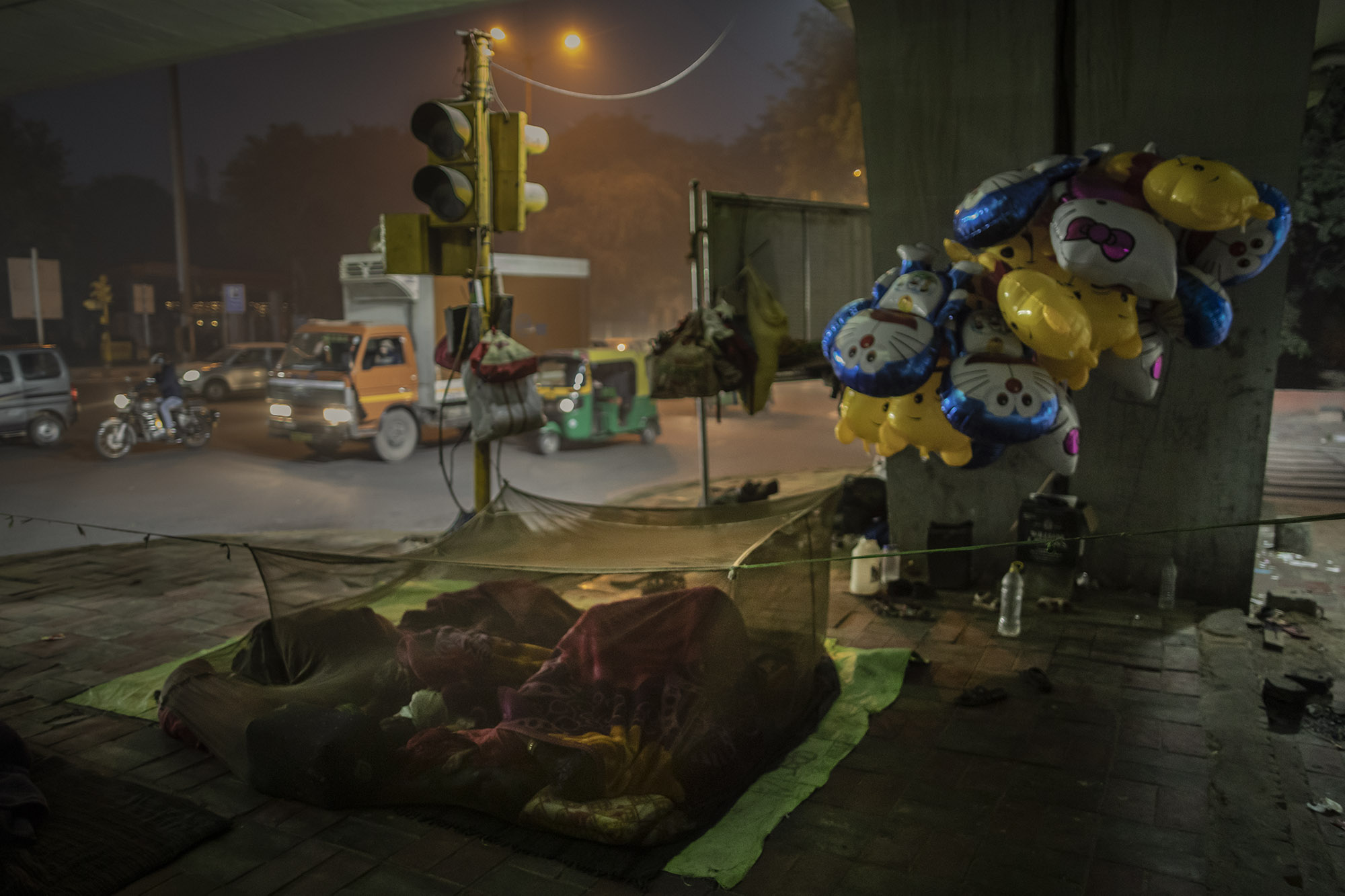
Rukmani’s family sleeps under mosquito netting on the side of the road. © Santi Palacios for Sonda Internacional
Thousands of people sleep on the streets of Delhi, exposing themselves to high levels of pollution. According to the 2011 census (the most recent data available), around 47,000 people live on the streets. There are organizations that point to a much higher number, with some suggesting that there may be between 150,000 and 200,000 homeless people.
BONFIRES
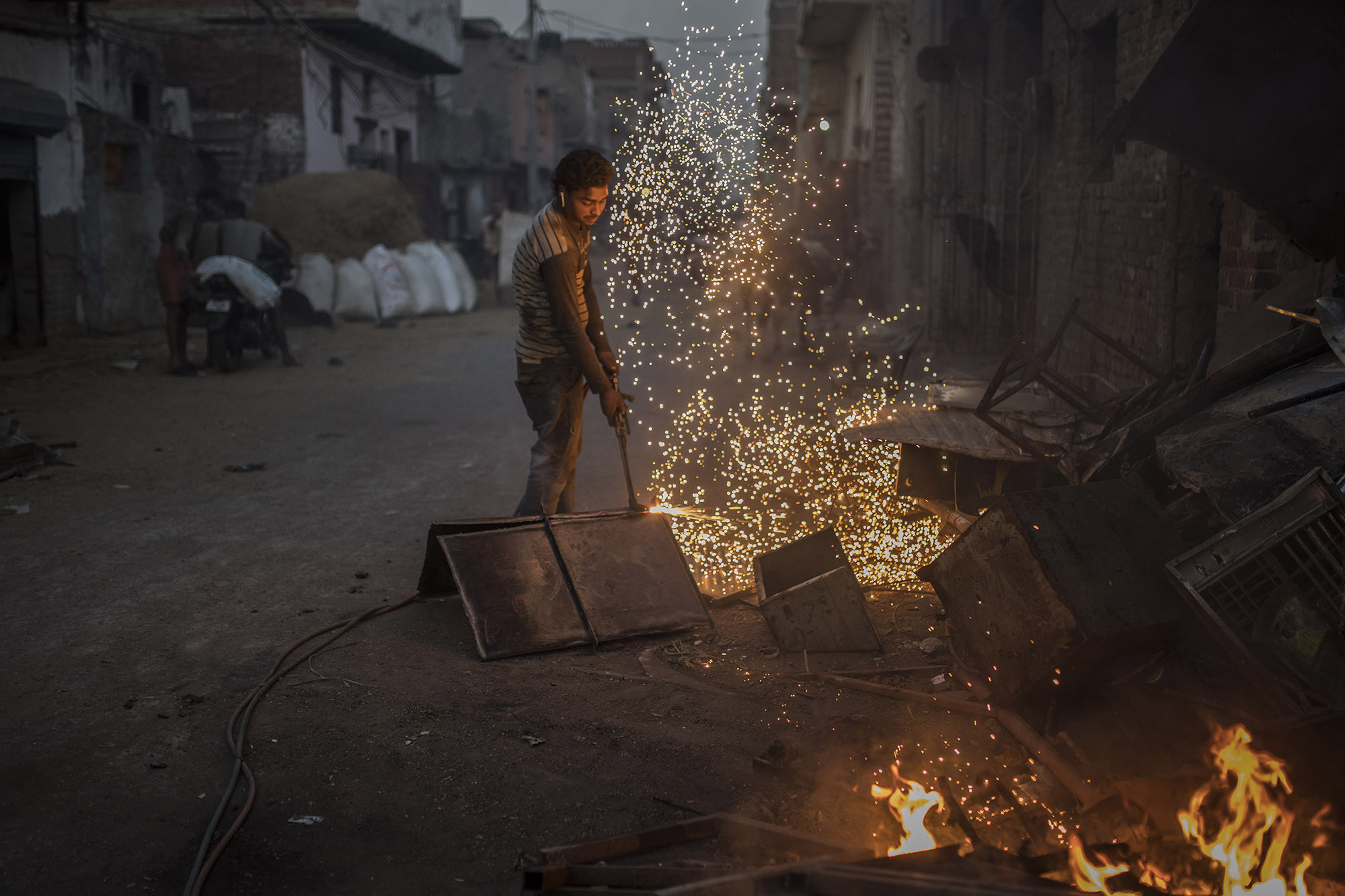
A young man melts scrap metal two blocks from the Ghazipur landfill, Delhi. © Santi Palacios for Sonda Internacional
Millions of people burn bonfires each day for work, cooking, or for warmth.
Although this practice is illegal and has been punishable by a fine since 2015, burning trash or fuel is customary. Bonfires burn constantly in shanty towns and residential areas, in courtyards and in the street. But where this practice is most common is at the city’s landfills. In addition to intentional fires set to burn trash, the accumulation of organic waste at the dumpsites produces methane gas which burns fairly easily.
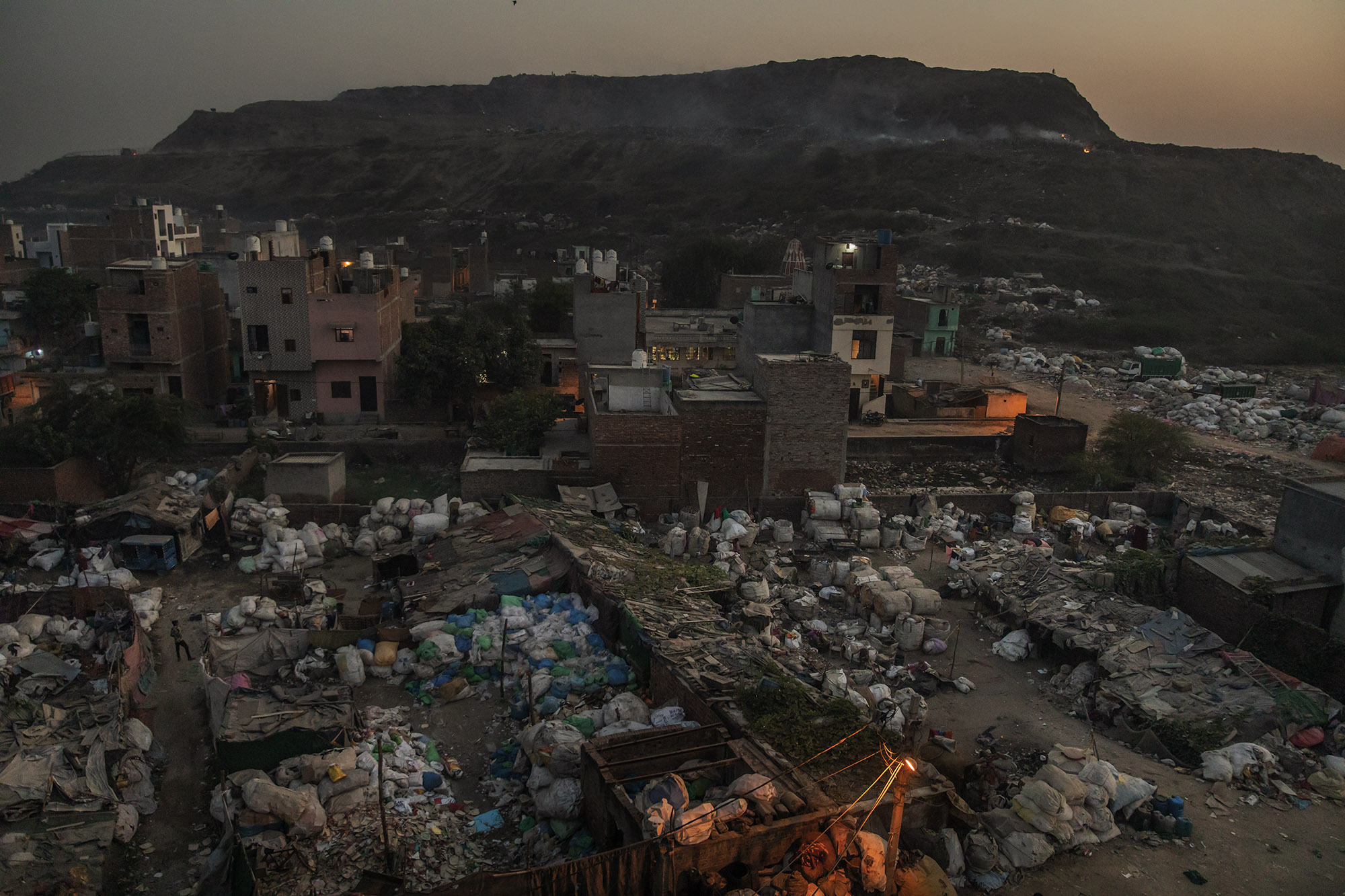
In the background, the mountain of garbage at the Bhalswa landfill, Delhi. And at the foot of the mountain, part of the adjacent shanty town. © Santi Palacios for Sonda Internacional
Half a dozen fires broke out in Delhi's landfills in the first four months of 2022 alone. At the Bhalswa landfill, one of the largest in the city, an enormous fire broke out in April, lasting several days and releasing enormous amounts of toxic smoke into the atmosphere. At least one school in the area was forced to close, and large areas of the north of the capital were shrouded in a mantle of gray smoke. PM2.5 levels shot up to ten times the limit considered safe by Indian officials.
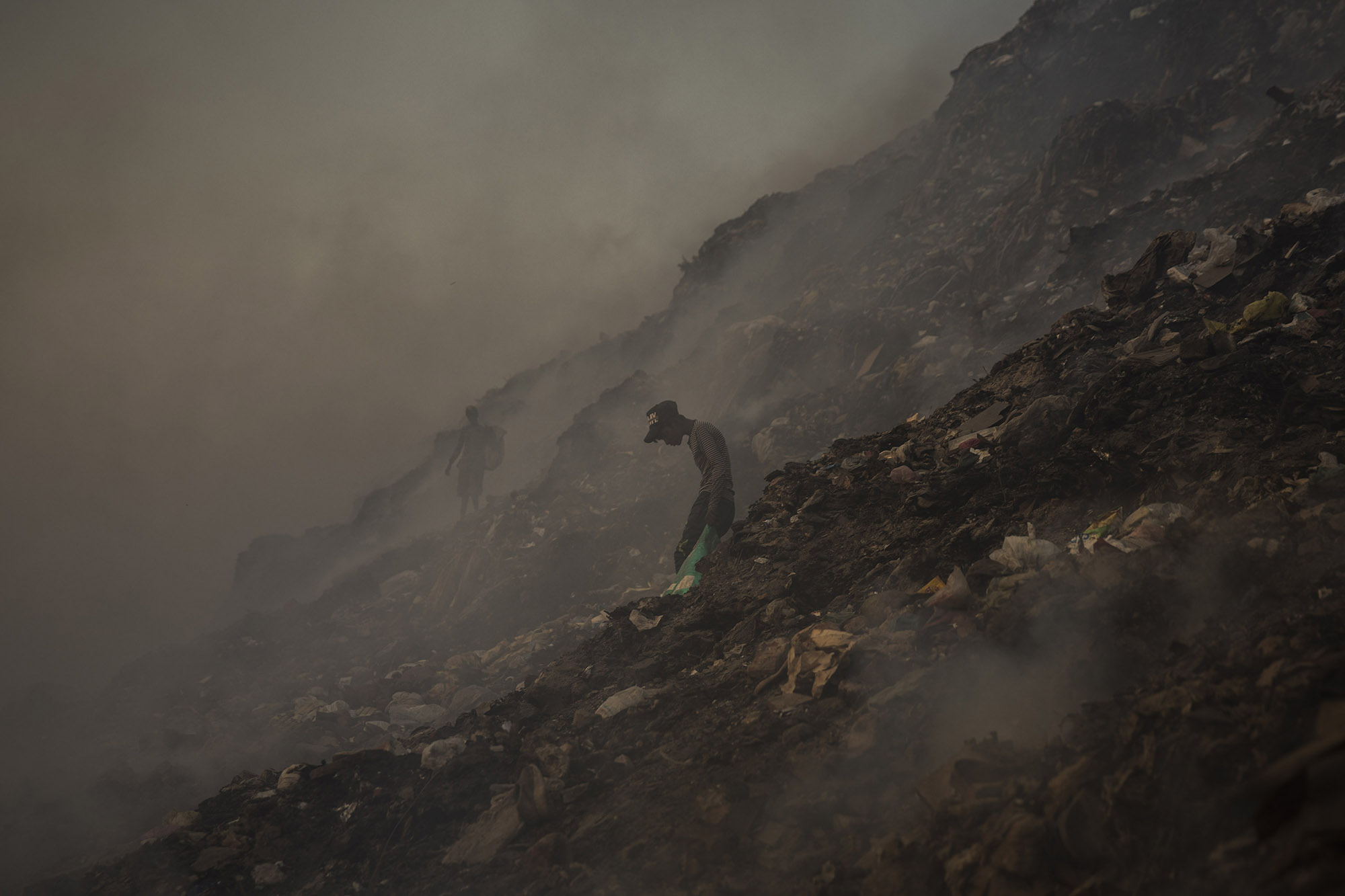
Two young boys search for metal to recycle among the columns of smoke from a fire in the Bhalswa landfill. © Santi Palacios for Sonda Internacional
Bhalswa, like other landfills, is one of the epicenters of environmental pollution in Delhi. More than 2,000 tons of garbage are dumped there each day. Thousands of people work among the mountains of garbage, breathing harmful air day after day. Residents of nearby neighborhoods are also engulfed by this toxic atmosphere, and many people suffer from respiratory illnesses or skin and stomach problems.
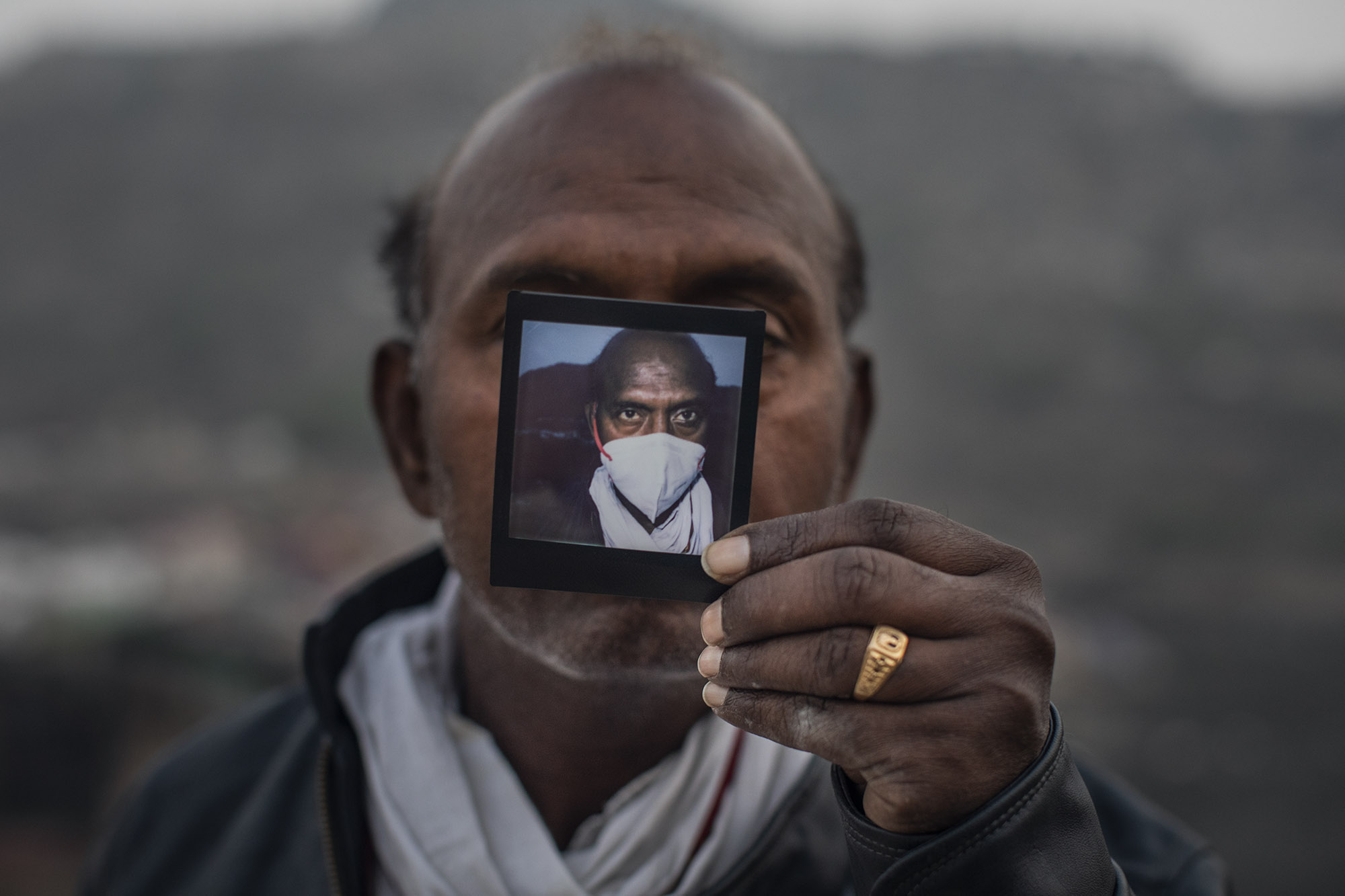
Jawahar Yadav holds up a photo that shows how he protects himself from the polluted air. He has been living behind a mask since long before Covid-19. © Santi Palacios for Sonda Internacional
Jawahar
Jawahar Yadav lives with his family in the shanty town that spreads out from the foot of the Bhalswa landfill. He is 50 years old and he came to the area more than 30 years ago from the state of Bihar, in northeastern India. His home stands just over a quarter of a mile from the gigantic mound of garbage. At night he can see bonfires where people are burning their waste.
Jawahar has been wearing a face mask since well before the Coronavirus pandemic. He has undergone a kidney transplant, a donation from his wife Madu Malha Devi, and he is now among the people considered to be most vulnerable to pollution. His doctors have prescribed the use of a face covering at all times to avoid the risk of infection.
His face mask quickly becomes dirty from the dust that permeates this neighborhood of unpaved streets. Practically every morning the area awakens to a thick blanket of smog. Alongside a road that supports a constant flow of garbage trucks is a canal running with sewage. Apart from his house, which is a simple two-story building, Jawahar —a devout Hindu— owns a piece of land where he is building a small temple.
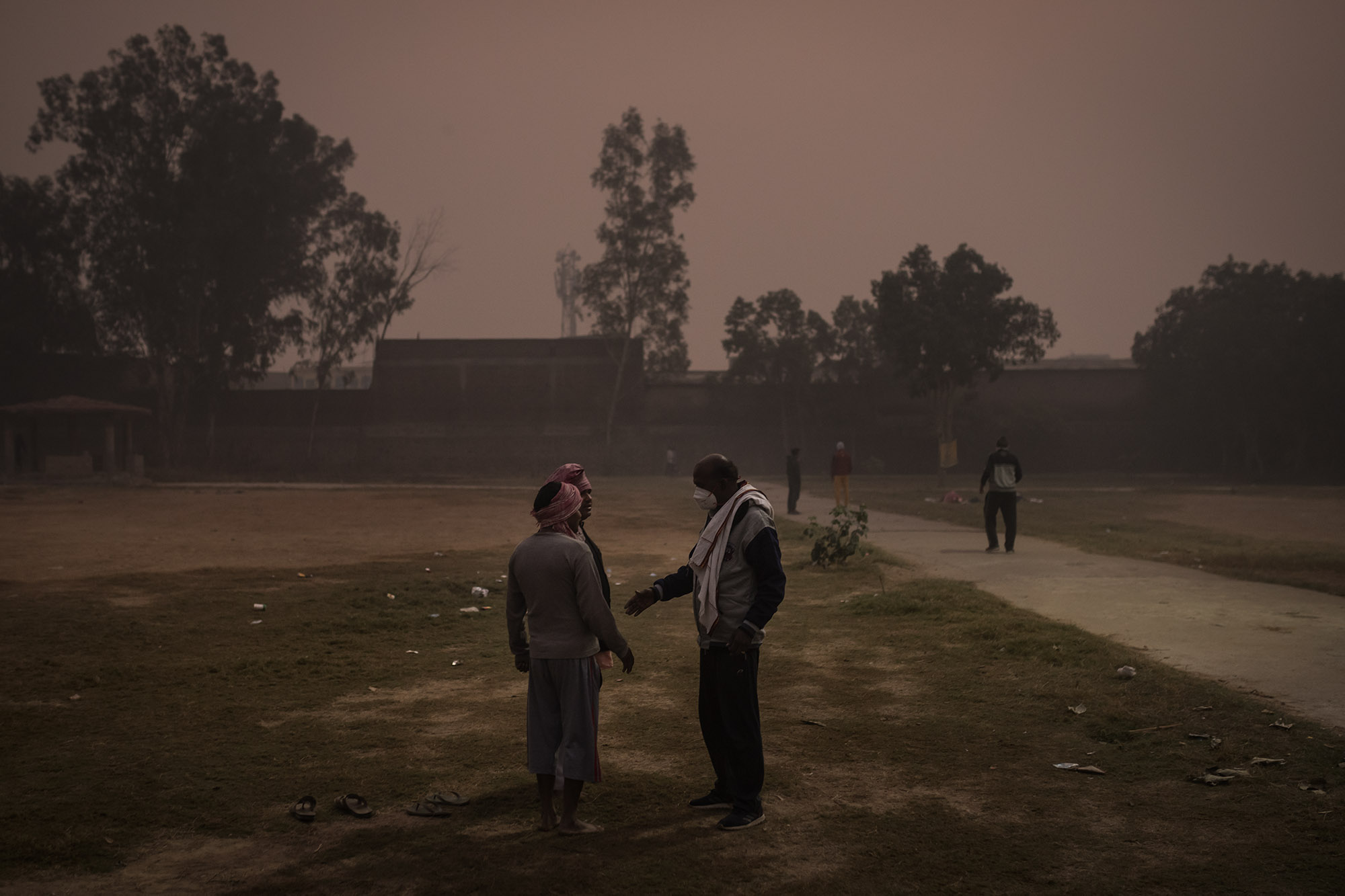
Jawahar greets his neighbors in a nearby park choked with smog. © Santi Palacios for Sonda Internacional
“Sometimes I think that if I could sell my land for a good price I would maybe go to Haridwar [in northern India]. There is less pollution, and it is a sacred city.”
Jawahar Yadav. Bhalswa.
CONSTRUCTION
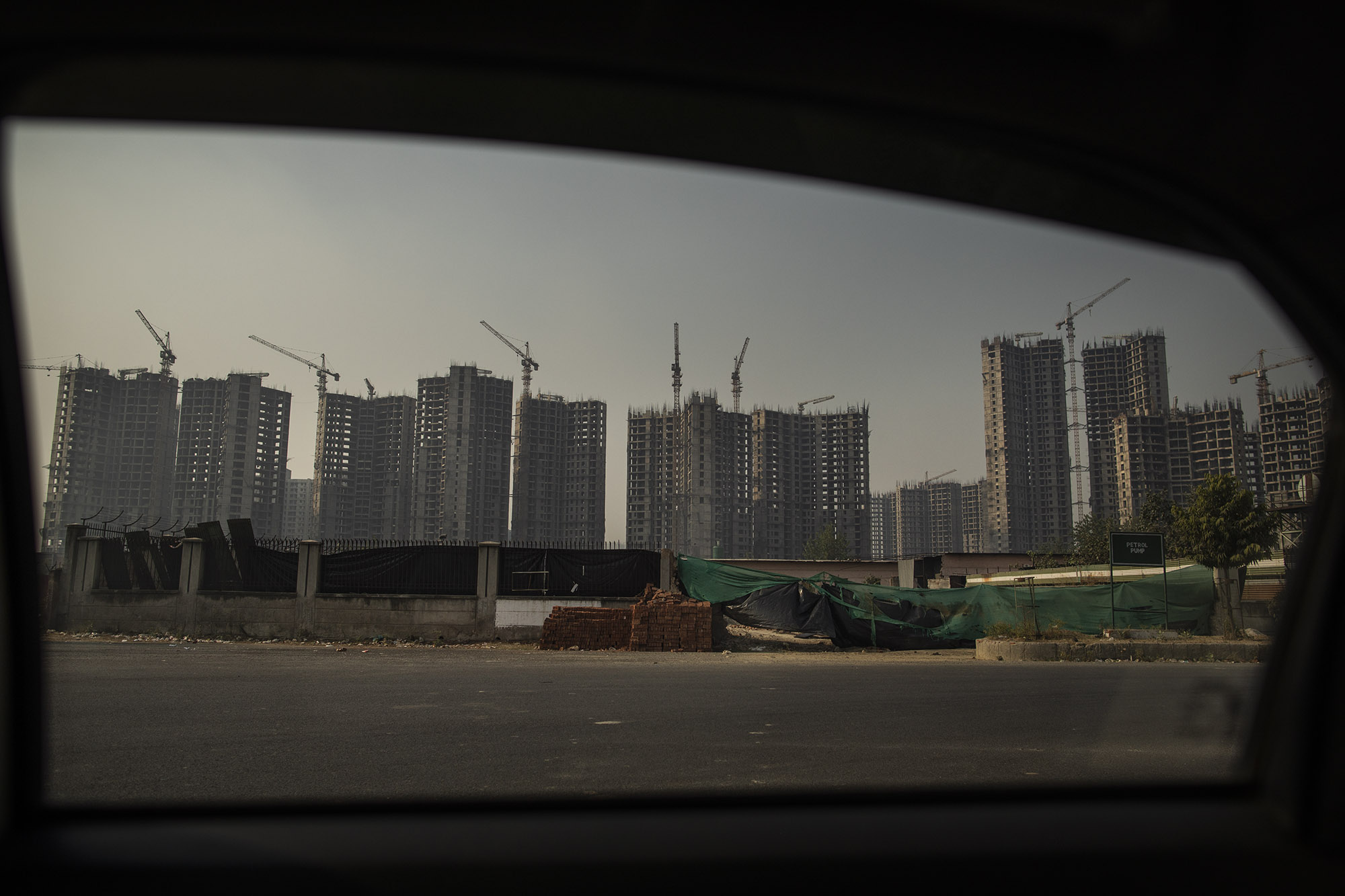
There are always active construction sites in the city of Delhi, which is constantly growing and transforming, and these sites contribute to the number of microparticles in the air. Any site occupying more than one and a quarter acre must have between one and four anti-smog guns, enormous water vaporizers that settle the dust and other suspended particles in the atmosphere. When air quality reaches the “severe” category, all construction is halted, with the exception of strategic projects and those related to national security.
This prohibition is part of GRAP (Graded Response Action Plan), a mechanism created in 2017 by which a set of emergency measures —from school closures to traffic limitations— kick in when air pollution surpasses certain thresholds. The worse the pollution, the stricter the measures.
Ankita and Pushpendra
Ankita Agrawal and Pushpendra Yadav live in Noida, a satellite city of Delhi that seems to be constantly under construction. The city is home to multiple tech enterprises, which has attracted young professionals like Ankita and Pushpendra.
When the couple bought their apartment in Noida in 2015, they could not imagine what a burden it would become. On days when the pollution is particularly bad, you can barely see the towers that are being built opposite their building —brick behemoths that seem as though they will never be finished. The layer of gray in the distance is pollution. It is always there.
"At first we thought it was fog,” says Ankita. She is holding her one-month-old baby, Anush, as we speak. But they soon realized that the “fog” was actually smog, causing itching and burning in their eyes and throat.
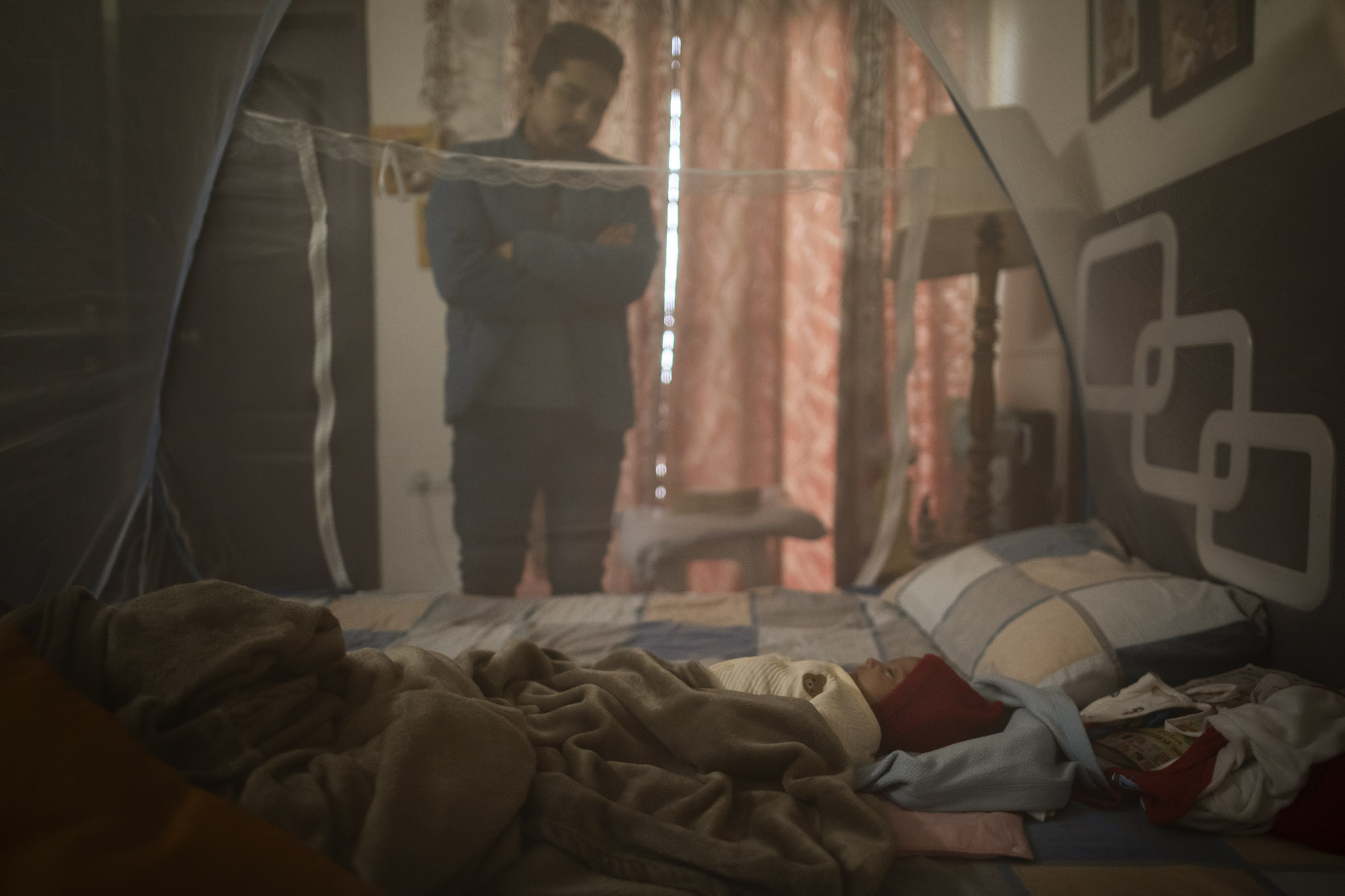
Pushpendra watches his one-month-old son Anush through mosquito netting. © Santi Palacios for Sonda Internacional
“The pollution has been a very negative factor in our lives. We don't go out for walks or to do sports. Our son still hasn’t developed immunity. He's only a month old,” says Ankita.
The couple did not take their baby outside during his first 30 days for fear of how the pollution might affect him. They only took him to the pediatrician for his required vaccinations. They say that the doctor told them, “Ok, that's everything. Now all you have to do is get him out of Delhi.”
Ankita will take their son to the south of India while she is on maternity leave.
Even though Ankita and Pushpendra have their home, work and friends in Noida, they are considering moving to get away from the pollution. “Perhaps elsewhere in India, or if we can, we will leave the country.”
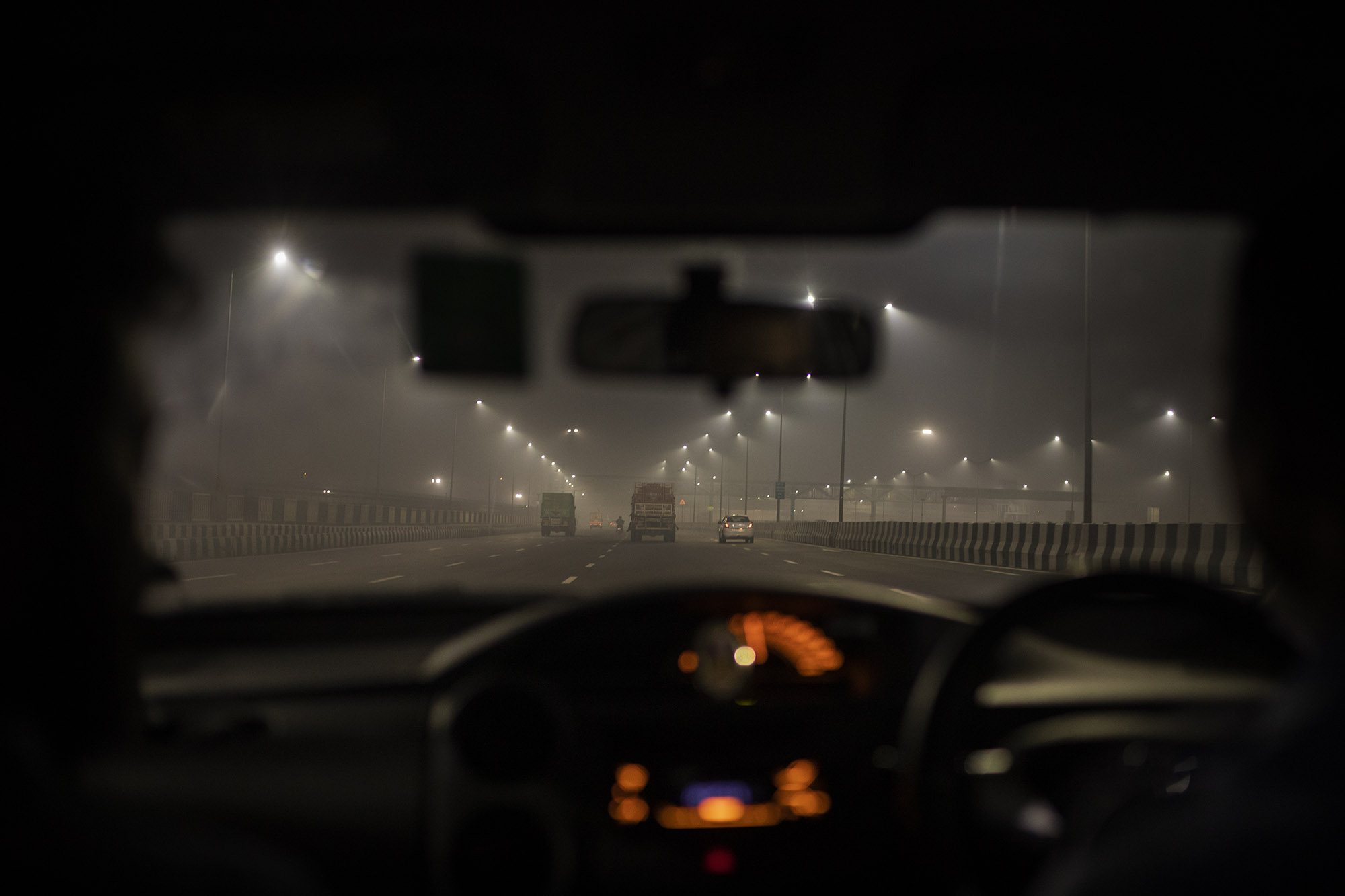
Smog envelops the roads in Delhi on a winter day registering high levels of pollution. © Santi Palacios for Sonda Internacional
“If things don’t change, I see no future for Delhi.”
Ankita Agrawal. Noida.
INDUSTRIAL EMISSIONS
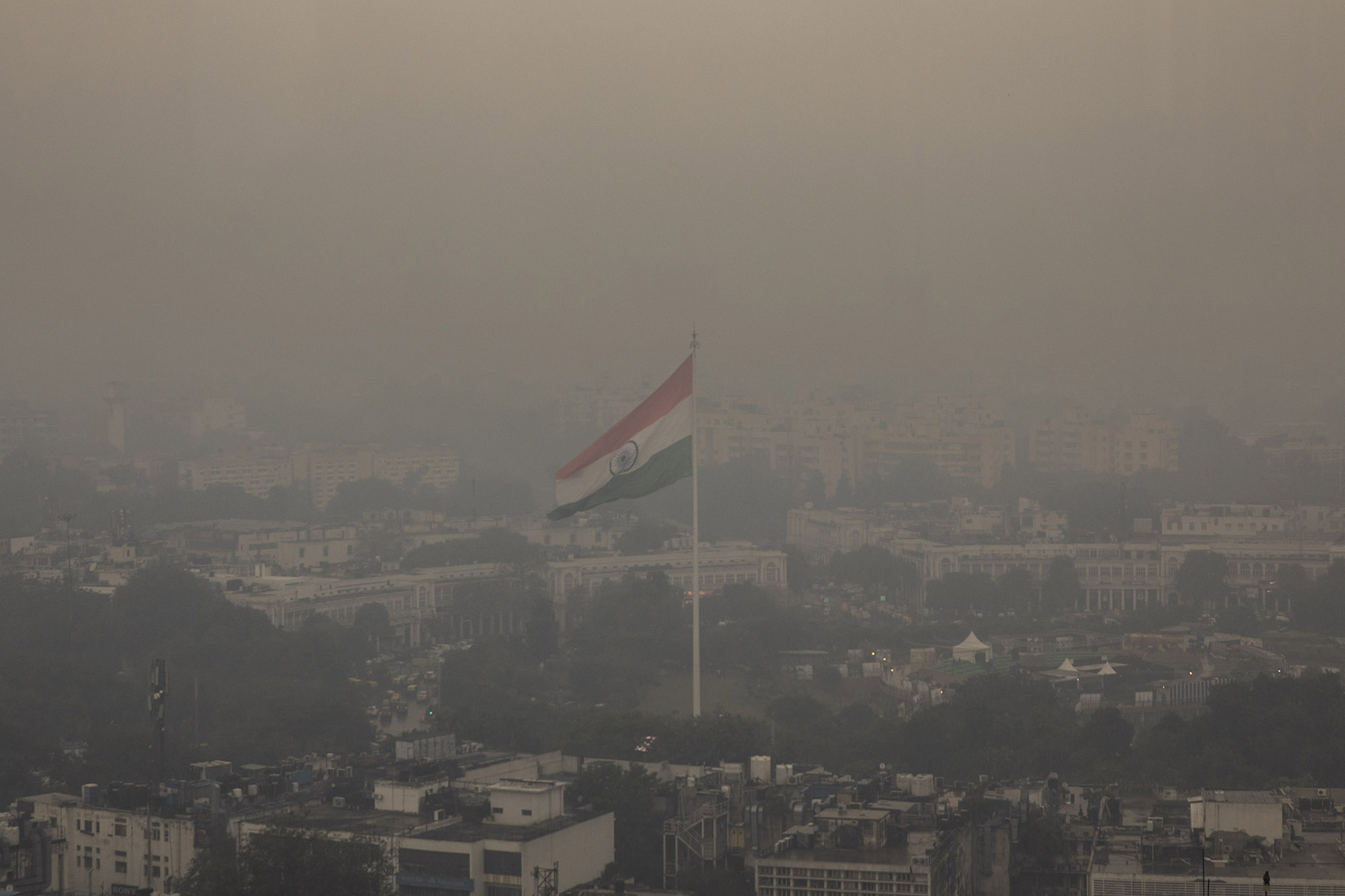
A blanket of smog chokes Connaught Place, an emblematic square in the center of New Delhi. © Santi Palacios for Sonda Internacional
With thousands of factories of all sizes spread throughout the region of the Indian capital, it is estimated that nearly 30% of Delhi's environmental pollution comes from industrial emissions. The poor air quality crisis has prompted local officials to prohibit the use of coal as an industrial or domestic source of fuel in the entire National Capital Territory of Delhi beginning in 2023. The only exception for now will be thermal energy plants, which are actually the greatest consumers of coal.
At the COP26 conference held in Glasgow in November 2021, it was India that lobbied, together with China, to eliminate the global goal of “phasing out” coal from the Climate Pact, editing instead for a “phase down”, to the chagrin of the nations that are most vulnerable to climate change.
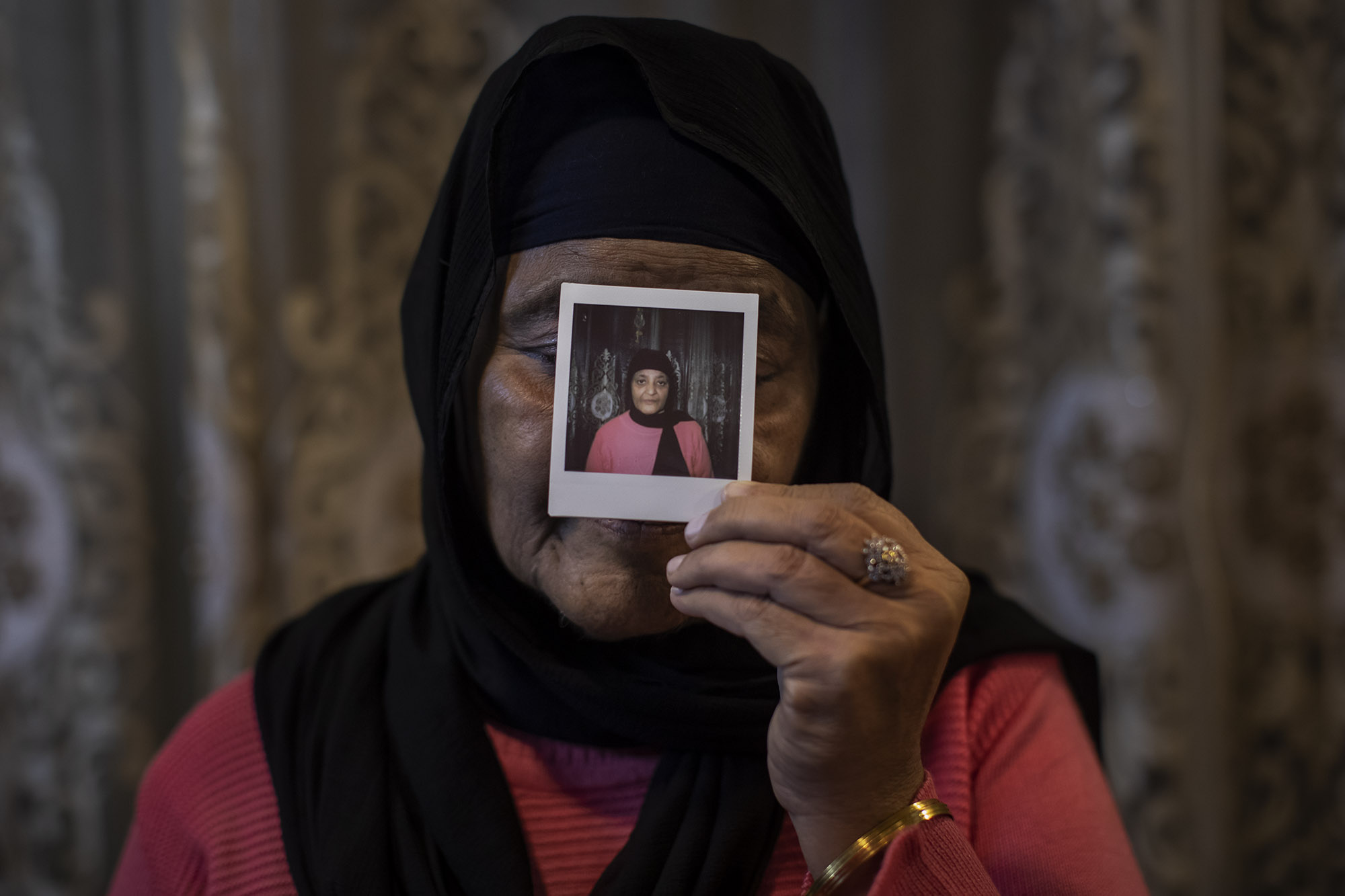
Ashish doesn’t take any special precautions to protect herself from the pollution. Here she holds up a photo of how she leaves the house on a normal day. © Santi Palacios for Sonda Internacional
Ashish
Ashish was diagnosed with a brain tumor in 2018, when she was 60 years old. They operated immediately, and the biopsy revealed that the tumor was the result of metastasis from advanced-stage lung cancer. She was not a smoker, nor had she been exposed to cigarette smoke. She did not work in an environment that put her at risk of inhaling toxic substances, nor did she have a family history of cancer. The only carcinogenic determinant her doctors were able to identify was the air she breathed.
Anand Vihar —the locality where Ashish lives with her husband, her daughter-in-law and her two grandchildren— is one of the most polluted areas in Delhi due to its proximity to an industrial zone, a bus terminal and a constant flow of traffic.
Ashish’s oncologist, Meenu Walia, practices at Max Super Specialty Hospital in Vaishali, on the outskirts of Delhi. She cannot be one hundred percent certain whether Ashish’s cancer was caused by pollution, but she does point out that statistics show a greater correlation between high levels of pollution and a higher rate of lung cancer in patients who are not otherwise at risk. Doctor Sharad Joshi, a lung specialist at Max Hospital, is categorical. “It is indisputable that pollution causes cancer,” he says. “We have young patients who have never smoked that come to us with lung cancer. When we operate, we find that their lungs are black. After twenty years breathing the polluted air of Delhi, a person’s lungs become gray or black.”
According to a study performed by the Lung Care Foundation in India at the end of the 1980s, only 10% of lung cancer patients were non-smokers. By 2018, the percentage had risen to 50%.
CROP BURNING
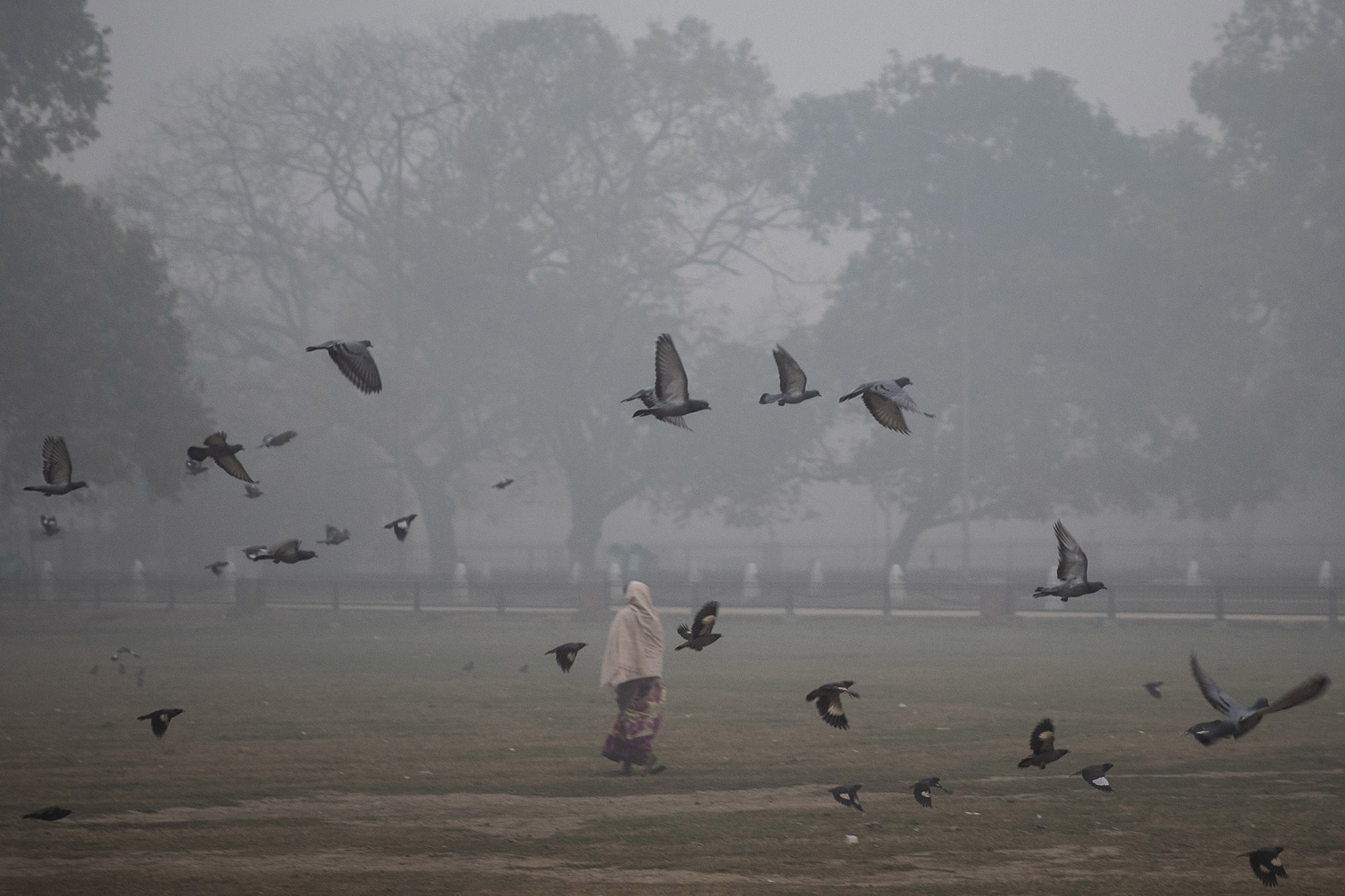
Smog fills the air in a park in the center of New Delhi. © Santi Palacios for Sonda Internacional
New Delhi has poor air quality year round, but it is worse in winter when the air becomes almost unbreathable. Beginning in October or November the polluting factors of the city are compounded by others such as the arrival of the cold weather —which causes a higher concentration of particulates closer to the ground— and the smoke from seasonal crop burning in the regions surrounding Delhi, particularly Haryana and Punjab.
The practice of agricultural burning is by far the most controversial among those who live in the capital. City officials place the blame on farmers for the spikes in pollution, although the actual effect that this activity has on the city's air quality is unclear. The Indian government determined last year that it contributes to between 4% and 10% of poor air quality —far behind traffic and industry—, while other studies suggest that this figure may be higher.

The farmers insist that they use this practice out of necessity. Mechanized agriculture means that after harvesting their crops, they have to burn the stubble so they can sow the fields again in time. They claim that it is the megalopolis of Delhi, with its high population density, heavy traffic and numerous industries that is to blame for its own pollution.
Regardless of the actual contribution of crop burning to the city's poor air quality, it is a fact that the wind and other meteorological factors cause the smoke from thousands of agricultural fires to concentrate over the city of Delhi and beyond, even reaching as far as northeast India.
In states that burn larger expanses of stubble, pollution levels during the burn season surge to two or three times the safe limit established by the Indian government, while cases of respiratory disease increase among people in all age groups. “Winter is a difficult time. In just the first 15 days we treat 25% more patients,” says lung specialist Sharad Joshi from Max Hospital in Delhi.

Jai Dhar Gupta holds up a photo of the face mask he uses to protect himself from the polluted air. © Santi Palacios for Sonda Internacional
Jai
An entrepreneur and an activist, Jai Dhar Gupta lives in Gurgaon, one of New Delhi's other satellite cities, and he is passionate about the fight against pollution. He has experienced the effects of the astronomical levels of pollution firsthand. In 2013 he suffered a lung collapse after several weeks of jogging on the streets of Delhi. It took him months to recover, and it marked the beginning of a new journey: he studied the different types of pollution, the applicable anti-smog measures in places like Beijing, and the most effective methods of self-protection.
This research led him to found a successful brand of air purifiers and face masks, as well as to become one of the most active voices in the fight against pollution.
Apart from participating in demonstrations and televised debates, Jai created a movement called My Right to Breathe to raise awareness of the risks of pollution and to mobilize those who suffer its effects in the city of Delhi.
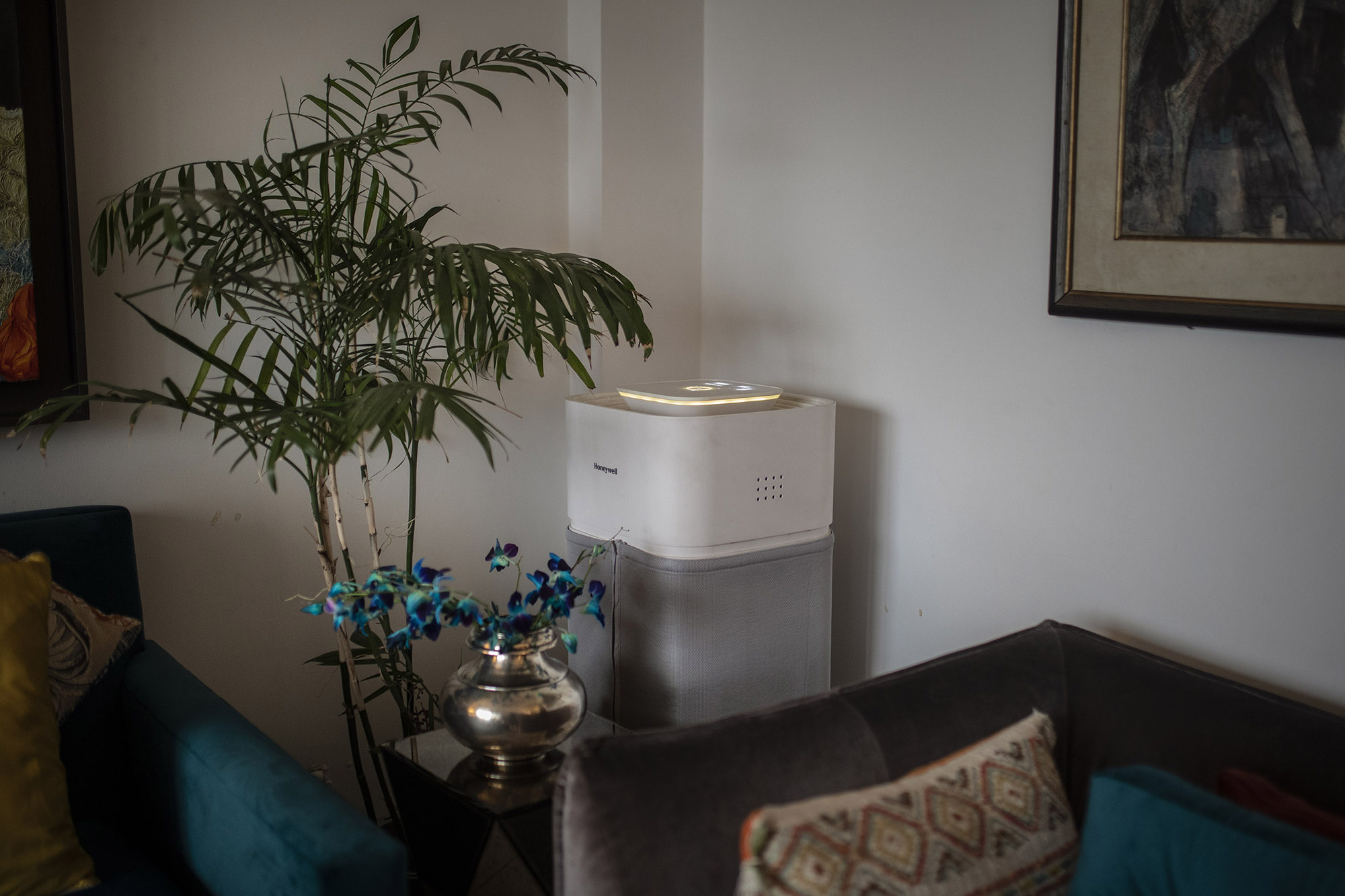
One of the air purifiers that Jai Dhar Gupta has installed in his home. © Santi Palacios for Sonda Internacional
He has also created an authentic bubble of clean air in his personal space: he has air purifiers fitted in his offices and in his small electric car, and there is a device installed in every room of his home.
“Breathing the air inside my house is like being in the Swiss Alps,” he says jokingly.
The levels registered on the pollution monitor he shows us corroborate his claim.
“How can you prevent the negative impact of air pollution? Breathing is something we do constantly. You can’t not breathe. The only way is by keeping the air clean.”
Dr. Sharad Joshi, pulmonologist. Max Hospital, Vaishali (Delhi)
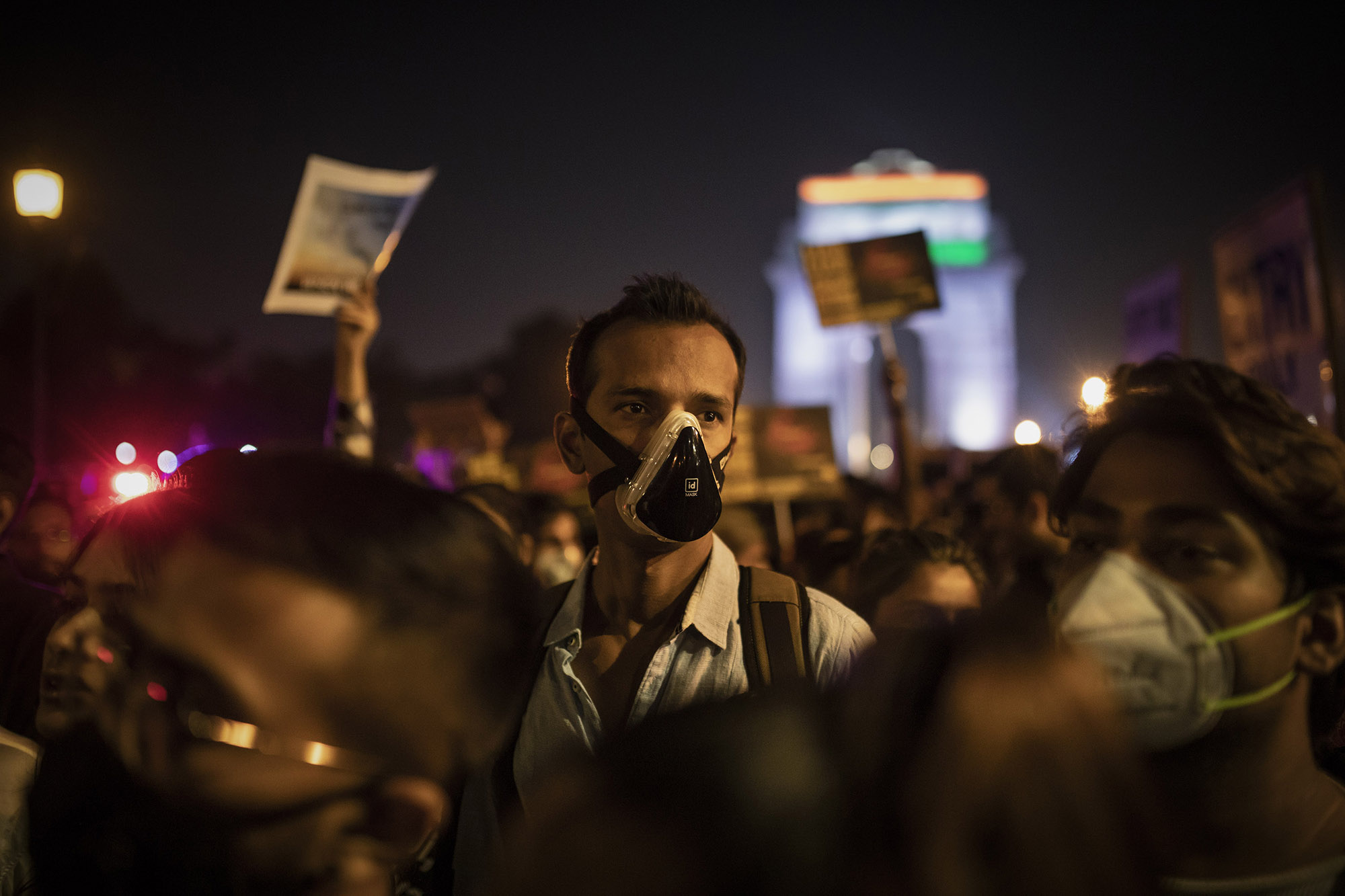
Protest against air pollution, India Gate, New Delhi. © Santi Palacios for Sonda Internacional


